Change Management in Global Shipping Industry: A Case Study of CMA CGM
VerifiedAdded on 2023/04/22
|28
|5629
|152
AI Summary
This report explores the changes in the global shipping industry and how leading companies like CMA CGM are embracing them. It covers the drivers of change, forces resisting change, and the vision and mission of CMA CGM. The report also includes a force field analysis and resource implementation plan.
Contribute Materials
Your contribution can guide someone’s learning journey. Share your
documents today.
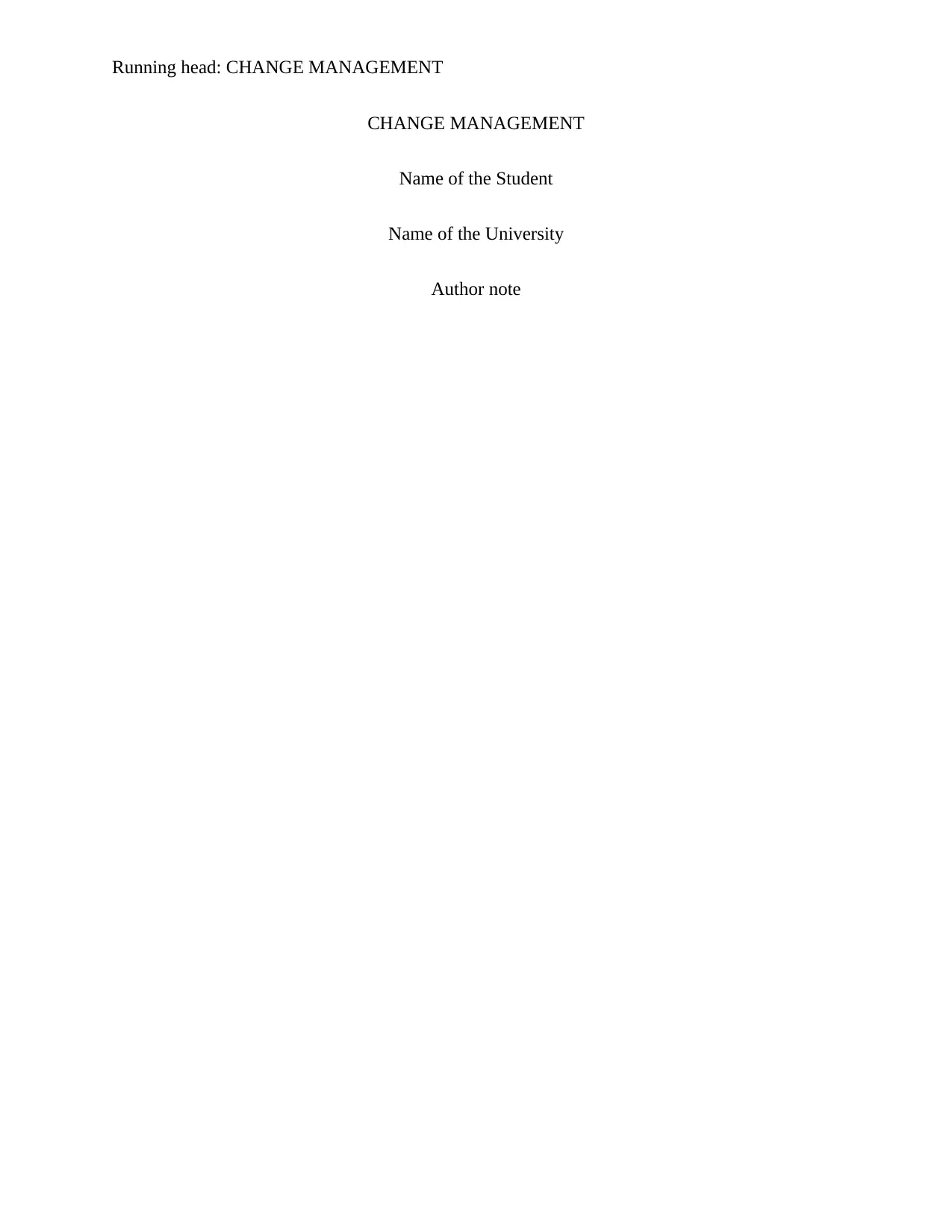
Running head: CHANGE MANAGEMENT
CHANGE MANAGEMENT
Name of the Student
Name of the University
Author note
CHANGE MANAGEMENT
Name of the Student
Name of the University
Author note
Secure Best Marks with AI Grader
Need help grading? Try our AI Grader for instant feedback on your assignments.
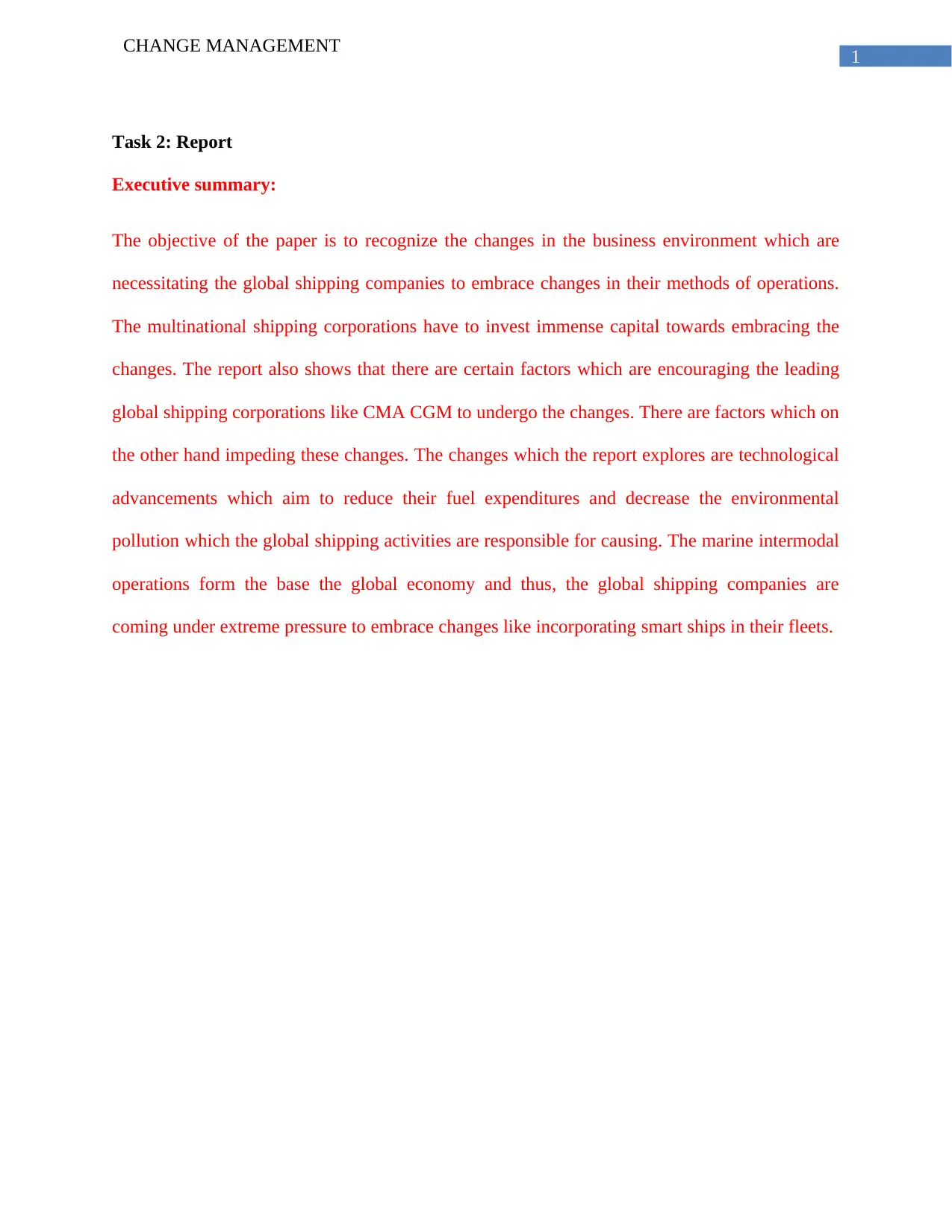
1
CHANGE MANAGEMENT
Task 2: Report
Executive summary:
The objective of the paper is to recognize the changes in the business environment which are
necessitating the global shipping companies to embrace changes in their methods of operations.
The multinational shipping corporations have to invest immense capital towards embracing the
changes. The report also shows that there are certain factors which are encouraging the leading
global shipping corporations like CMA CGM to undergo the changes. There are factors which on
the other hand impeding these changes. The changes which the report explores are technological
advancements which aim to reduce their fuel expenditures and decrease the environmental
pollution which the global shipping activities are responsible for causing. The marine intermodal
operations form the base the global economy and thus, the global shipping companies are
coming under extreme pressure to embrace changes like incorporating smart ships in their fleets.
CHANGE MANAGEMENT
Task 2: Report
Executive summary:
The objective of the paper is to recognize the changes in the business environment which are
necessitating the global shipping companies to embrace changes in their methods of operations.
The multinational shipping corporations have to invest immense capital towards embracing the
changes. The report also shows that there are certain factors which are encouraging the leading
global shipping corporations like CMA CGM to undergo the changes. There are factors which on
the other hand impeding these changes. The changes which the report explores are technological
advancements which aim to reduce their fuel expenditures and decrease the environmental
pollution which the global shipping activities are responsible for causing. The marine intermodal
operations form the base the global economy and thus, the global shipping companies are
coming under extreme pressure to embrace changes like incorporating smart ships in their fleets.
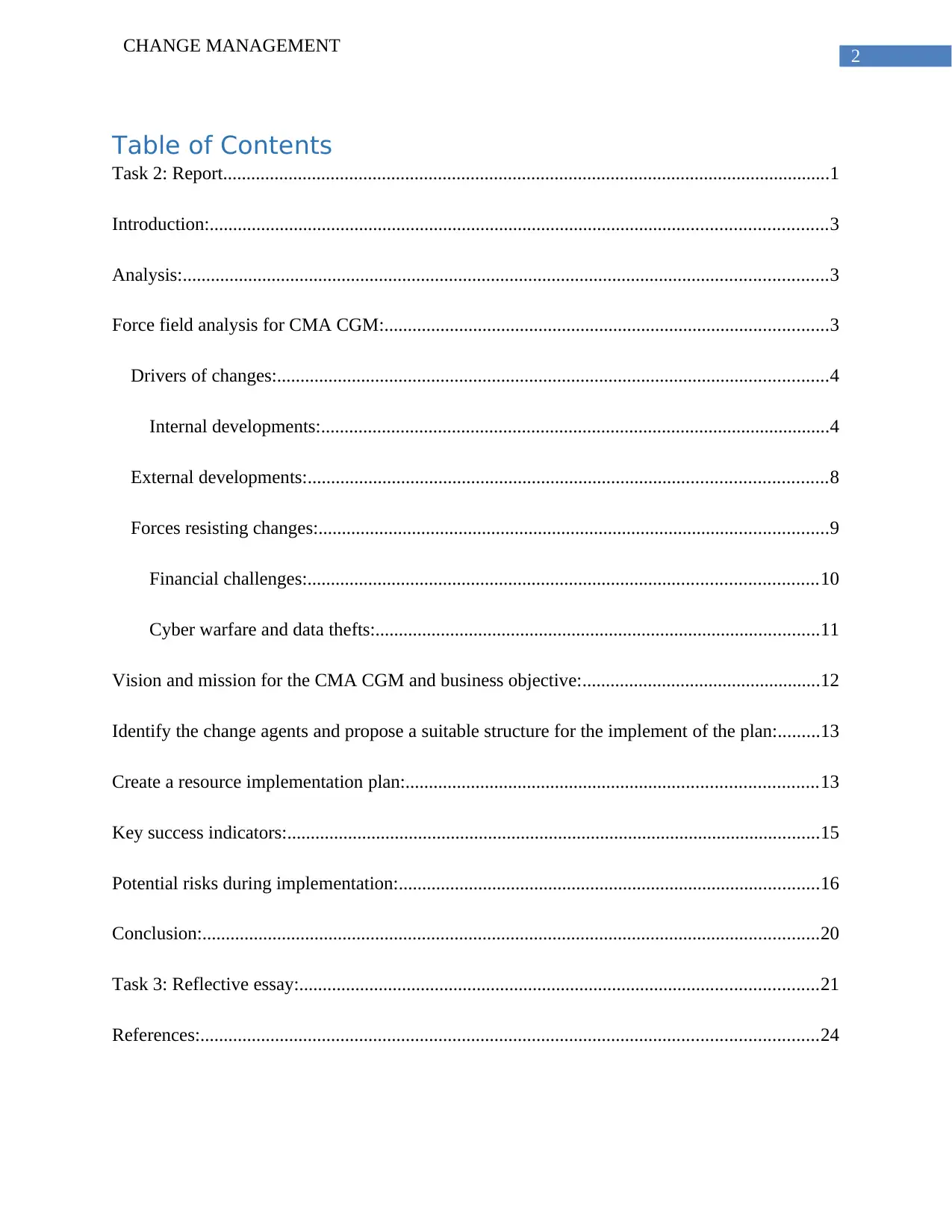
2
CHANGE MANAGEMENT
Table of Contents
Task 2: Report..................................................................................................................................1
Introduction:....................................................................................................................................3
Analysis:..........................................................................................................................................3
Force field analysis for CMA CGM:...............................................................................................3
Drivers of changes:......................................................................................................................4
Internal developments:.............................................................................................................4
External developments:...............................................................................................................8
Forces resisting changes:.............................................................................................................9
Financial challenges:.............................................................................................................10
Cyber warfare and data thefts:...............................................................................................11
Vision and mission for the CMA CGM and business objective:...................................................12
Identify the change agents and propose a suitable structure for the implement of the plan:.........13
Create a resource implementation plan:........................................................................................13
Key success indicators:..................................................................................................................15
Potential risks during implementation:..........................................................................................16
Conclusion:....................................................................................................................................20
Task 3: Reflective essay:...............................................................................................................21
References:....................................................................................................................................24
CHANGE MANAGEMENT
Table of Contents
Task 2: Report..................................................................................................................................1
Introduction:....................................................................................................................................3
Analysis:..........................................................................................................................................3
Force field analysis for CMA CGM:...............................................................................................3
Drivers of changes:......................................................................................................................4
Internal developments:.............................................................................................................4
External developments:...............................................................................................................8
Forces resisting changes:.............................................................................................................9
Financial challenges:.............................................................................................................10
Cyber warfare and data thefts:...............................................................................................11
Vision and mission for the CMA CGM and business objective:...................................................12
Identify the change agents and propose a suitable structure for the implement of the plan:.........13
Create a resource implementation plan:........................................................................................13
Key success indicators:..................................................................................................................15
Potential risks during implementation:..........................................................................................16
Conclusion:....................................................................................................................................20
Task 3: Reflective essay:...............................................................................................................21
References:....................................................................................................................................24

3
CHANGE MANAGEMENT
Introduction:
The global marine logistics and container industry is undergoing a sea of changes which
likely accelerate the shipping industry. These changes ranging from using of block chain
technology and more advanced or smart ships are boosting the shipping industry. However, there
are changes which are posing real threats like sea trade growth in slowing down, international
market conditions becoming more unpredictable and need to adapt to the new customer demands
(Deloitte.com. 2019). While the positive drivers of changes are encouraging the container
companies embrace changes, the impeding factors are try to stop or at least lower the change
rate. These conditions have taken every container company under their influences and even the
leading multinational shipping companies are no exceptions (Parker and Tyedmers 2015). The
aim of the essay would be study the force field taking into account both the positive and negative
drivers of changes. The company which would render a strong base to the study would be the
world’s third largest shipping and container transportation company, CMA CGM S.A, .having its
base in France (Cma-cgm.com. 2019).
Analysis:
Force field analysis for CMA CGM:
The force field analysis of CMA CGM should point out that factors which are
encouraging the changes and factors which are impeding the changes which the company needs
to embrace to gain higher level of sustainability. Maritime and Port Authority of Singapore while
shedding light on the technological developments, one of the strongest drivers of sustainability in
the shipping industry divides the drivers into two categories. The first category of drivers are
internal developments while the second category of drivers are external developments
(Mpa.gov.sg. 2019). The report does not shed light on the resistance which the shipping
CHANGE MANAGEMENT
Introduction:
The global marine logistics and container industry is undergoing a sea of changes which
likely accelerate the shipping industry. These changes ranging from using of block chain
technology and more advanced or smart ships are boosting the shipping industry. However, there
are changes which are posing real threats like sea trade growth in slowing down, international
market conditions becoming more unpredictable and need to adapt to the new customer demands
(Deloitte.com. 2019). While the positive drivers of changes are encouraging the container
companies embrace changes, the impeding factors are try to stop or at least lower the change
rate. These conditions have taken every container company under their influences and even the
leading multinational shipping companies are no exceptions (Parker and Tyedmers 2015). The
aim of the essay would be study the force field taking into account both the positive and negative
drivers of changes. The company which would render a strong base to the study would be the
world’s third largest shipping and container transportation company, CMA CGM S.A, .having its
base in France (Cma-cgm.com. 2019).
Analysis:
Force field analysis for CMA CGM:
The force field analysis of CMA CGM should point out that factors which are
encouraging the changes and factors which are impeding the changes which the company needs
to embrace to gain higher level of sustainability. Maritime and Port Authority of Singapore while
shedding light on the technological developments, one of the strongest drivers of sustainability in
the shipping industry divides the drivers into two categories. The first category of drivers are
internal developments while the second category of drivers are external developments
(Mpa.gov.sg. 2019). The report does not shed light on the resistance which the shipping
Secure Best Marks with AI Grader
Need help grading? Try our AI Grader for instant feedback on your assignments.
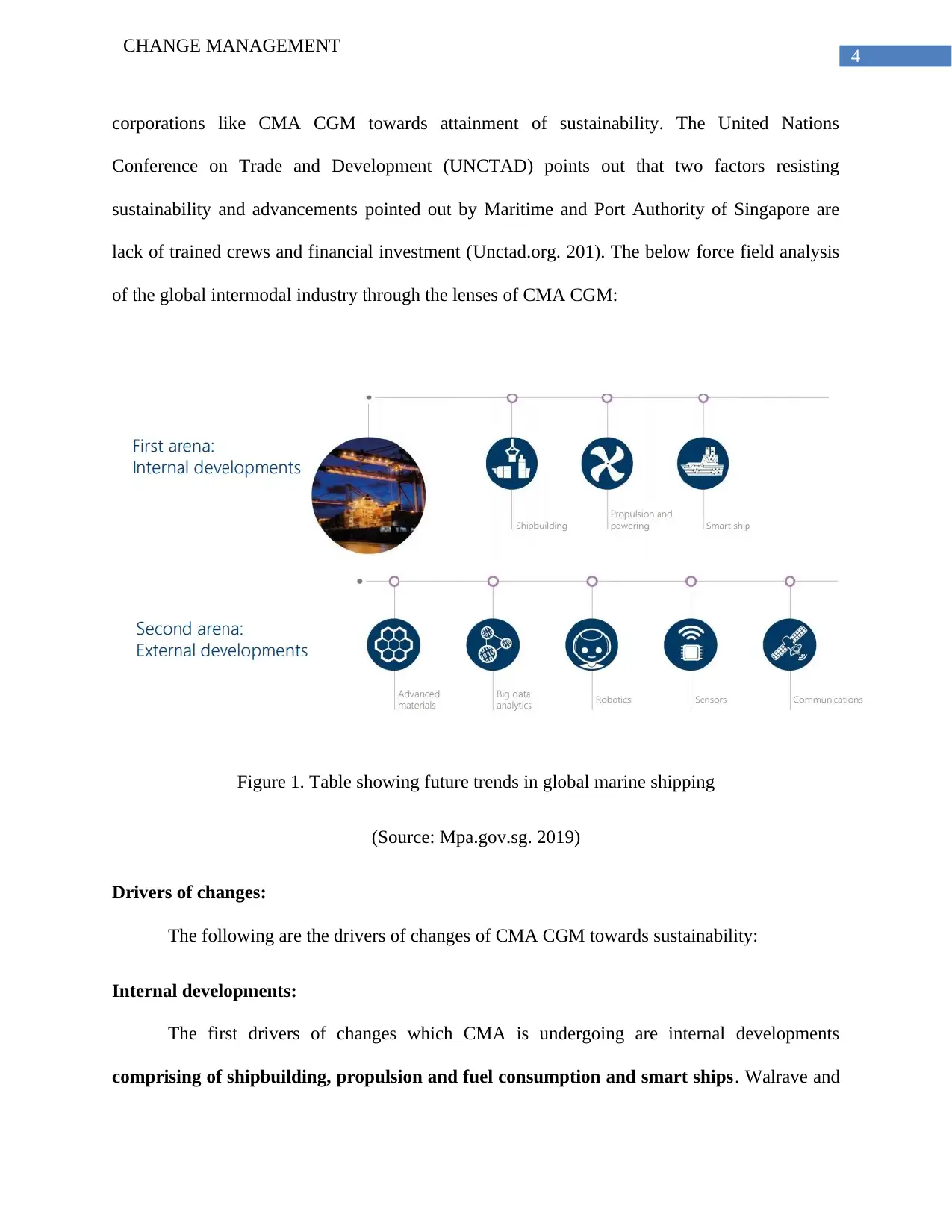
4
CHANGE MANAGEMENT
corporations like CMA CGM towards attainment of sustainability. The United Nations
Conference on Trade and Development (UNCTAD) points out that two factors resisting
sustainability and advancements pointed out by Maritime and Port Authority of Singapore are
lack of trained crews and financial investment (Unctad.org. 201). The below force field analysis
of the global intermodal industry through the lenses of CMA CGM:
Figure 1. Table showing future trends in global marine shipping
(Source: Mpa.gov.sg. 2019)
Drivers of changes:
The following are the drivers of changes of CMA CGM towards sustainability:
Internal developments:
The first drivers of changes which CMA is undergoing are internal developments
comprising of shipbuilding, propulsion and fuel consumption and smart ships. Walrave and
CHANGE MANAGEMENT
corporations like CMA CGM towards attainment of sustainability. The United Nations
Conference on Trade and Development (UNCTAD) points out that two factors resisting
sustainability and advancements pointed out by Maritime and Port Authority of Singapore are
lack of trained crews and financial investment (Unctad.org. 201). The below force field analysis
of the global intermodal industry through the lenses of CMA CGM:
Figure 1. Table showing future trends in global marine shipping
(Source: Mpa.gov.sg. 2019)
Drivers of changes:
The following are the drivers of changes of CMA CGM towards sustainability:
Internal developments:
The first drivers of changes which CMA is undergoing are internal developments
comprising of shipbuilding, propulsion and fuel consumption and smart ships. Walrave and

5
CHANGE MANAGEMENT
Raven (2016) mention that technological developments taking the internal operations of the
shipping companies are one of the biggest drivers of change. SHM Group, one of the leading
international shipping group mention use of consolidation is of the future drivers of changes in
the global marine industry. The shipping companies all-around of the globe are merging and
acquiring with shipping companies from diverse markets. This strategy of acquisition and merger
is allowing the shipping companies to pool their assets which in turn supports shipbuilding
(Shmgroup.com. 2019). For example, CMA in order to expand its asset base to support its
shipbuilding has signed letter of intent (LOI) with two ship building yards in China. This
consolidation would enable the company to build around nine 22000 TEU megaships.
The second drivers of changes in the marine intermodal industry are propulsion and fuel
consumption. Parker and Tyedmers (2015) echoes the opinion of Parker and Tyedmers (2015).
They mention that with the global marine intermodal industry slowing down and rising cost of
fuel, thus lowering revenue generation and increasing expenditure of the shipping companies
respectively. Deloitte in one of its 2017 reports reported that the global GDP has and the world
exports volume has followed the suit. However, the value of the exports has fallen which means
that the shipping companies need to take steps to curtail expenditures to minimize the losses they
would suffer due to falling exports value (Deloitte.com. 2019). The leading shipping companies
are using technology to manage this risks. CMA CGM in its official website mentions that it is
using technology like fast oil recovery system, shore power connection and 24*7 fleet navigation
centers to minimize fleet operational costs (Cma-cgm.com. 2019).
CHANGE MANAGEMENT
Raven (2016) mention that technological developments taking the internal operations of the
shipping companies are one of the biggest drivers of change. SHM Group, one of the leading
international shipping group mention use of consolidation is of the future drivers of changes in
the global marine industry. The shipping companies all-around of the globe are merging and
acquiring with shipping companies from diverse markets. This strategy of acquisition and merger
is allowing the shipping companies to pool their assets which in turn supports shipbuilding
(Shmgroup.com. 2019). For example, CMA in order to expand its asset base to support its
shipbuilding has signed letter of intent (LOI) with two ship building yards in China. This
consolidation would enable the company to build around nine 22000 TEU megaships.
The second drivers of changes in the marine intermodal industry are propulsion and fuel
consumption. Parker and Tyedmers (2015) echoes the opinion of Parker and Tyedmers (2015).
They mention that with the global marine intermodal industry slowing down and rising cost of
fuel, thus lowering revenue generation and increasing expenditure of the shipping companies
respectively. Deloitte in one of its 2017 reports reported that the global GDP has and the world
exports volume has followed the suit. However, the value of the exports has fallen which means
that the shipping companies need to take steps to curtail expenditures to minimize the losses they
would suffer due to falling exports value (Deloitte.com. 2019). The leading shipping companies
are using technology to manage this risks. CMA CGM in its official website mentions that it is
using technology like fast oil recovery system, shore power connection and 24*7 fleet navigation
centers to minimize fleet operational costs (Cma-cgm.com. 2019).
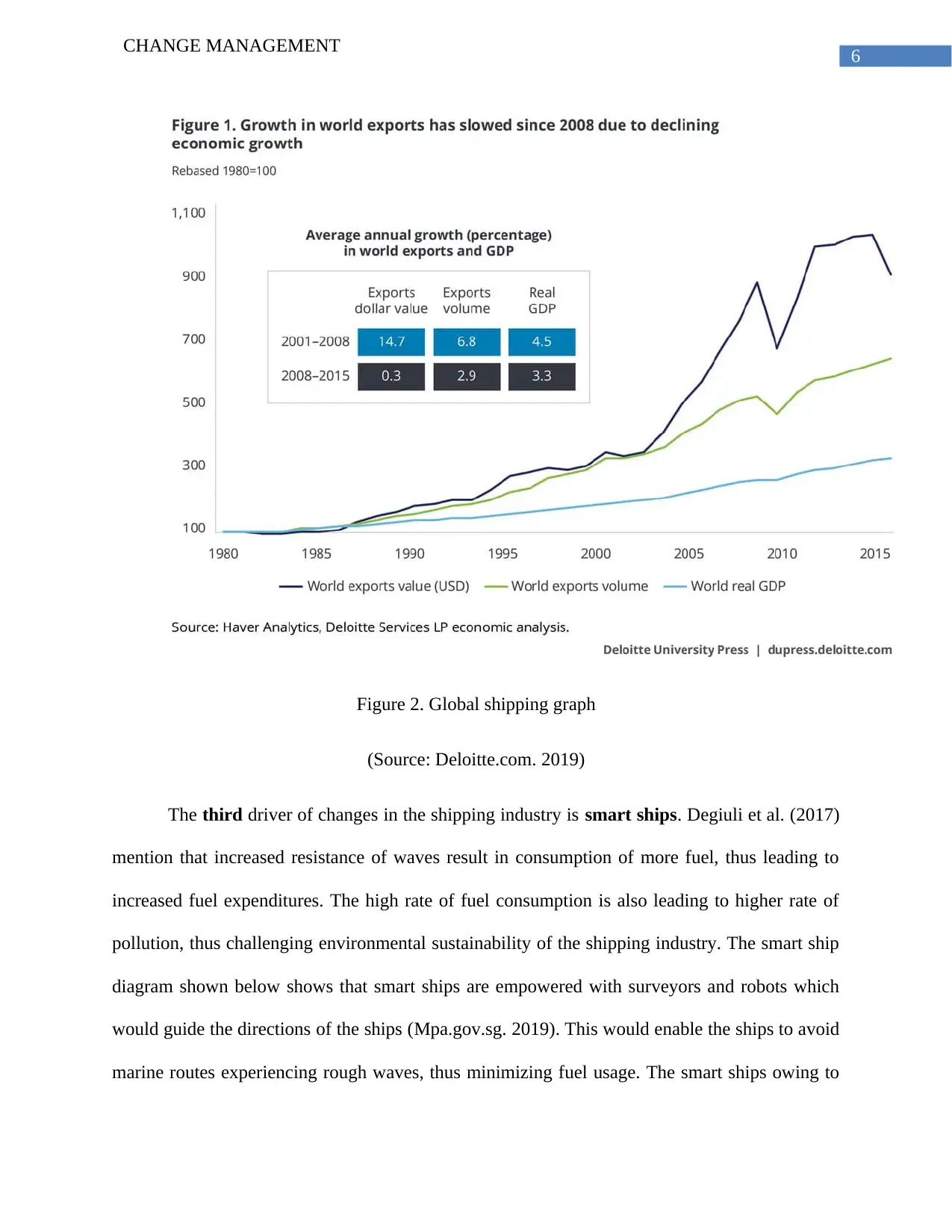
6
CHANGE MANAGEMENT
Figure 2. Global shipping graph
(Source: Deloitte.com. 2019)
The third driver of changes in the shipping industry is smart ships. Degiuli et al. (2017)
mention that increased resistance of waves result in consumption of more fuel, thus leading to
increased fuel expenditures. The high rate of fuel consumption is also leading to higher rate of
pollution, thus challenging environmental sustainability of the shipping industry. The smart ship
diagram shown below shows that smart ships are empowered with surveyors and robots which
would guide the directions of the ships (Mpa.gov.sg. 2019). This would enable the ships to avoid
marine routes experiencing rough waves, thus minimizing fuel usage. The smart ships owing to
CHANGE MANAGEMENT
Figure 2. Global shipping graph
(Source: Deloitte.com. 2019)
The third driver of changes in the shipping industry is smart ships. Degiuli et al. (2017)
mention that increased resistance of waves result in consumption of more fuel, thus leading to
increased fuel expenditures. The high rate of fuel consumption is also leading to higher rate of
pollution, thus challenging environmental sustainability of the shipping industry. The smart ship
diagram shown below shows that smart ships are empowered with surveyors and robots which
would guide the directions of the ships (Mpa.gov.sg. 2019). This would enable the ships to avoid
marine routes experiencing rough waves, thus minimizing fuel usage. The smart ships owing to
Paraphrase This Document
Need a fresh take? Get an instant paraphrase of this document with our AI Paraphraser
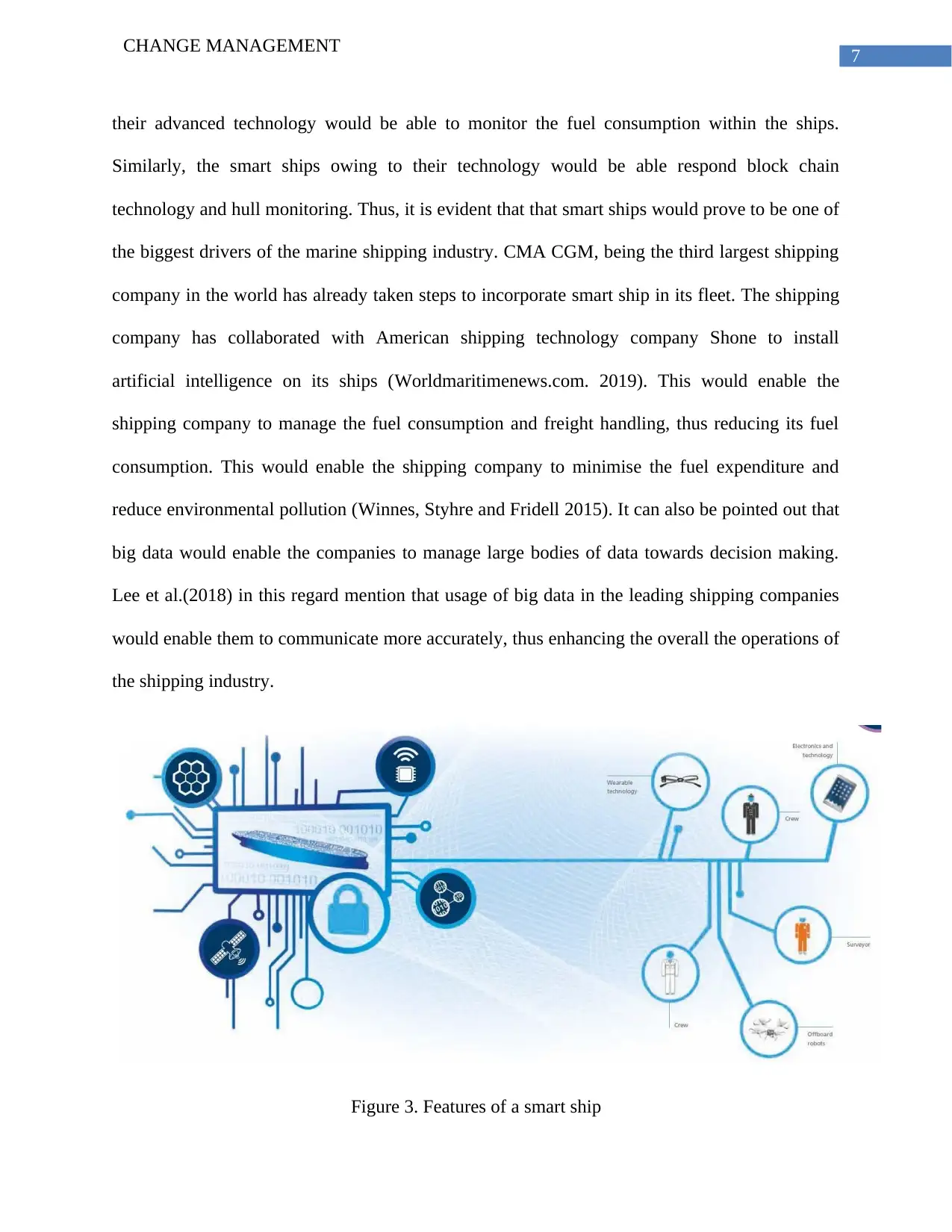
7
CHANGE MANAGEMENT
their advanced technology would be able to monitor the fuel consumption within the ships.
Similarly, the smart ships owing to their technology would be able respond block chain
technology and hull monitoring. Thus, it is evident that that smart ships would prove to be one of
the biggest drivers of the marine shipping industry. CMA CGM, being the third largest shipping
company in the world has already taken steps to incorporate smart ship in its fleet. The shipping
company has collaborated with American shipping technology company Shone to install
artificial intelligence on its ships (Worldmaritimenews.com. 2019). This would enable the
shipping company to manage the fuel consumption and freight handling, thus reducing its fuel
consumption. This would enable the shipping company to minimise the fuel expenditure and
reduce environmental pollution (Winnes, Styhre and Fridell 2015). It can also be pointed out that
big data would enable the companies to manage large bodies of data towards decision making.
Lee et al.(2018) in this regard mention that usage of big data in the leading shipping companies
would enable them to communicate more accurately, thus enhancing the overall the operations of
the shipping industry.
Figure 3. Features of a smart ship
CHANGE MANAGEMENT
their advanced technology would be able to monitor the fuel consumption within the ships.
Similarly, the smart ships owing to their technology would be able respond block chain
technology and hull monitoring. Thus, it is evident that that smart ships would prove to be one of
the biggest drivers of the marine shipping industry. CMA CGM, being the third largest shipping
company in the world has already taken steps to incorporate smart ship in its fleet. The shipping
company has collaborated with American shipping technology company Shone to install
artificial intelligence on its ships (Worldmaritimenews.com. 2019). This would enable the
shipping company to manage the fuel consumption and freight handling, thus reducing its fuel
consumption. This would enable the shipping company to minimise the fuel expenditure and
reduce environmental pollution (Winnes, Styhre and Fridell 2015). It can also be pointed out that
big data would enable the companies to manage large bodies of data towards decision making.
Lee et al.(2018) in this regard mention that usage of big data in the leading shipping companies
would enable them to communicate more accurately, thus enhancing the overall the operations of
the shipping industry.
Figure 3. Features of a smart ship
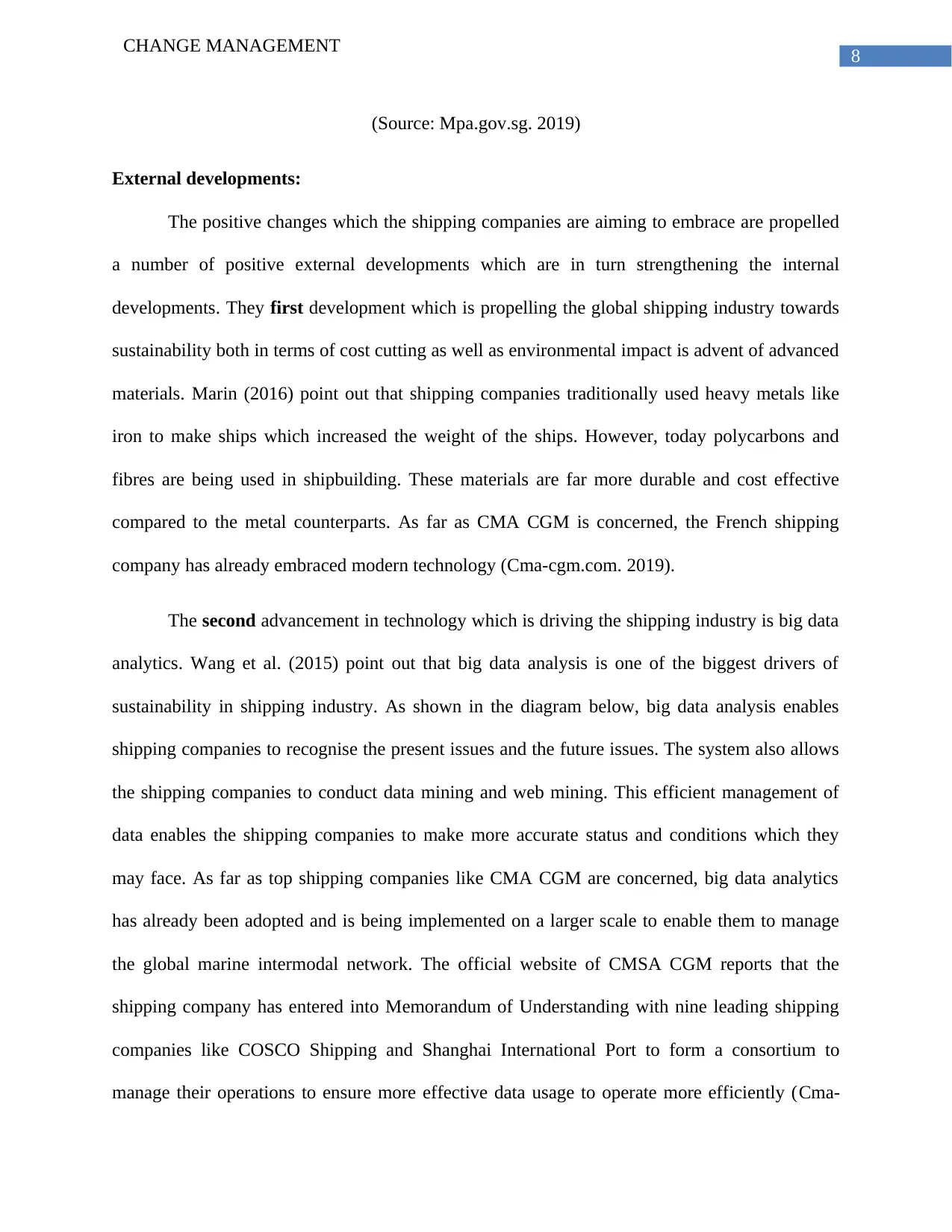
8
CHANGE MANAGEMENT
(Source: Mpa.gov.sg. 2019)
External developments:
The positive changes which the shipping companies are aiming to embrace are propelled
a number of positive external developments which are in turn strengthening the internal
developments. They first development which is propelling the global shipping industry towards
sustainability both in terms of cost cutting as well as environmental impact is advent of advanced
materials. Marin (2016) point out that shipping companies traditionally used heavy metals like
iron to make ships which increased the weight of the ships. However, today polycarbons and
fibres are being used in shipbuilding. These materials are far more durable and cost effective
compared to the metal counterparts. As far as CMA CGM is concerned, the French shipping
company has already embraced modern technology (Cma-cgm.com. 2019).
The second advancement in technology which is driving the shipping industry is big data
analytics. Wang et al. (2015) point out that big data analysis is one of the biggest drivers of
sustainability in shipping industry. As shown in the diagram below, big data analysis enables
shipping companies to recognise the present issues and the future issues. The system also allows
the shipping companies to conduct data mining and web mining. This efficient management of
data enables the shipping companies to make more accurate status and conditions which they
may face. As far as top shipping companies like CMA CGM are concerned, big data analytics
has already been adopted and is being implemented on a larger scale to enable them to manage
the global marine intermodal network. The official website of CMSA CGM reports that the
shipping company has entered into Memorandum of Understanding with nine leading shipping
companies like COSCO Shipping and Shanghai International Port to form a consortium to
manage their operations to ensure more effective data usage to operate more efficiently (Cma-
CHANGE MANAGEMENT
(Source: Mpa.gov.sg. 2019)
External developments:
The positive changes which the shipping companies are aiming to embrace are propelled
a number of positive external developments which are in turn strengthening the internal
developments. They first development which is propelling the global shipping industry towards
sustainability both in terms of cost cutting as well as environmental impact is advent of advanced
materials. Marin (2016) point out that shipping companies traditionally used heavy metals like
iron to make ships which increased the weight of the ships. However, today polycarbons and
fibres are being used in shipbuilding. These materials are far more durable and cost effective
compared to the metal counterparts. As far as CMA CGM is concerned, the French shipping
company has already embraced modern technology (Cma-cgm.com. 2019).
The second advancement in technology which is driving the shipping industry is big data
analytics. Wang et al. (2015) point out that big data analysis is one of the biggest drivers of
sustainability in shipping industry. As shown in the diagram below, big data analysis enables
shipping companies to recognise the present issues and the future issues. The system also allows
the shipping companies to conduct data mining and web mining. This efficient management of
data enables the shipping companies to make more accurate status and conditions which they
may face. As far as top shipping companies like CMA CGM are concerned, big data analytics
has already been adopted and is being implemented on a larger scale to enable them to manage
the global marine intermodal network. The official website of CMSA CGM reports that the
shipping company has entered into Memorandum of Understanding with nine leading shipping
companies like COSCO Shipping and Shanghai International Port to form a consortium to
manage their operations to ensure more effective data usage to operate more efficiently (Cma-
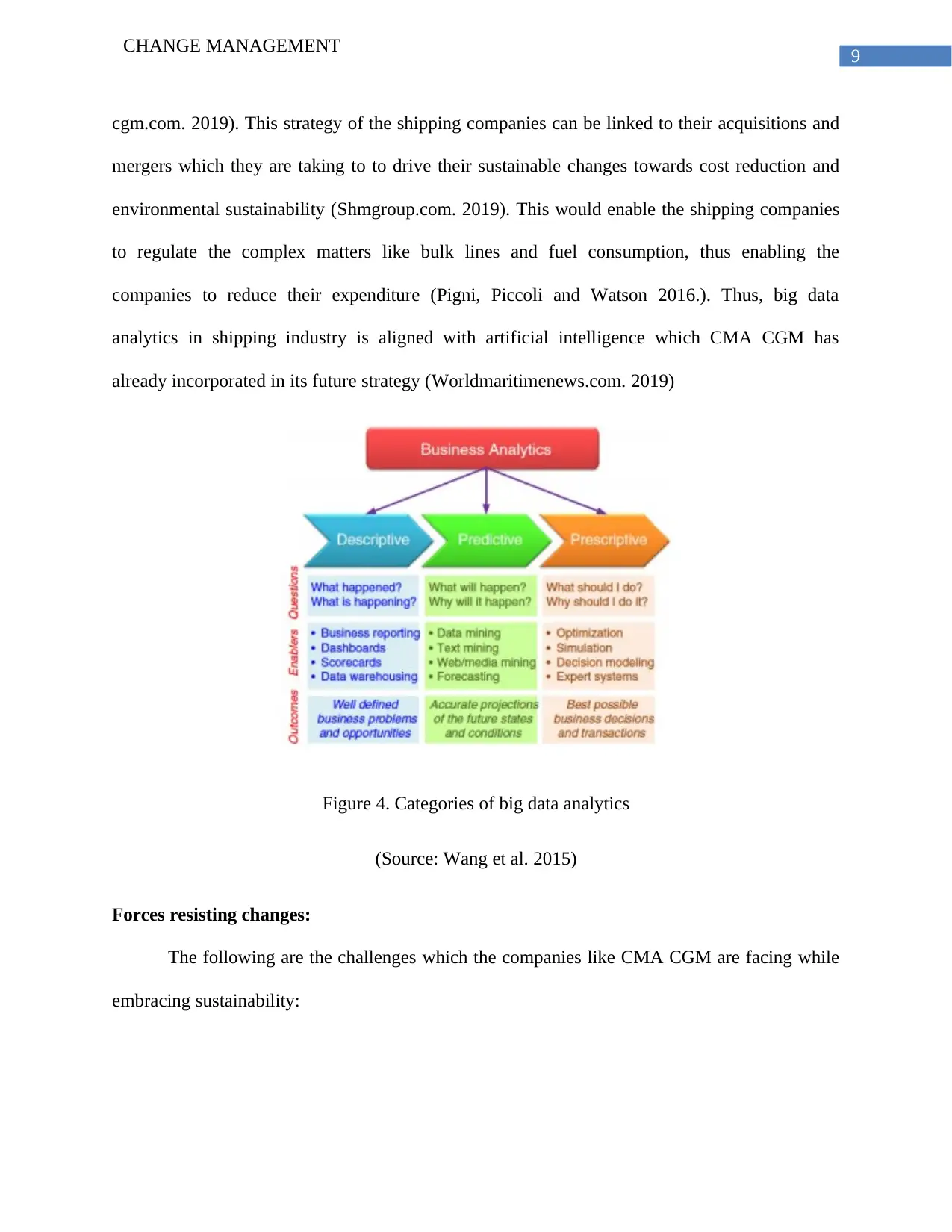
9
CHANGE MANAGEMENT
cgm.com. 2019). This strategy of the shipping companies can be linked to their acquisitions and
mergers which they are taking to to drive their sustainable changes towards cost reduction and
environmental sustainability (Shmgroup.com. 2019). This would enable the shipping companies
to regulate the complex matters like bulk lines and fuel consumption, thus enabling the
companies to reduce their expenditure (Pigni, Piccoli and Watson 2016.). Thus, big data
analytics in shipping industry is aligned with artificial intelligence which CMA CGM has
already incorporated in its future strategy (Worldmaritimenews.com. 2019)
Figure 4. Categories of big data analytics
(Source: Wang et al. 2015)
Forces resisting changes:
The following are the challenges which the companies like CMA CGM are facing while
embracing sustainability:
CHANGE MANAGEMENT
cgm.com. 2019). This strategy of the shipping companies can be linked to their acquisitions and
mergers which they are taking to to drive their sustainable changes towards cost reduction and
environmental sustainability (Shmgroup.com. 2019). This would enable the shipping companies
to regulate the complex matters like bulk lines and fuel consumption, thus enabling the
companies to reduce their expenditure (Pigni, Piccoli and Watson 2016.). Thus, big data
analytics in shipping industry is aligned with artificial intelligence which CMA CGM has
already incorporated in its future strategy (Worldmaritimenews.com. 2019)
Figure 4. Categories of big data analytics
(Source: Wang et al. 2015)
Forces resisting changes:
The following are the challenges which the companies like CMA CGM are facing while
embracing sustainability:
Secure Best Marks with AI Grader
Need help grading? Try our AI Grader for instant feedback on your assignments.
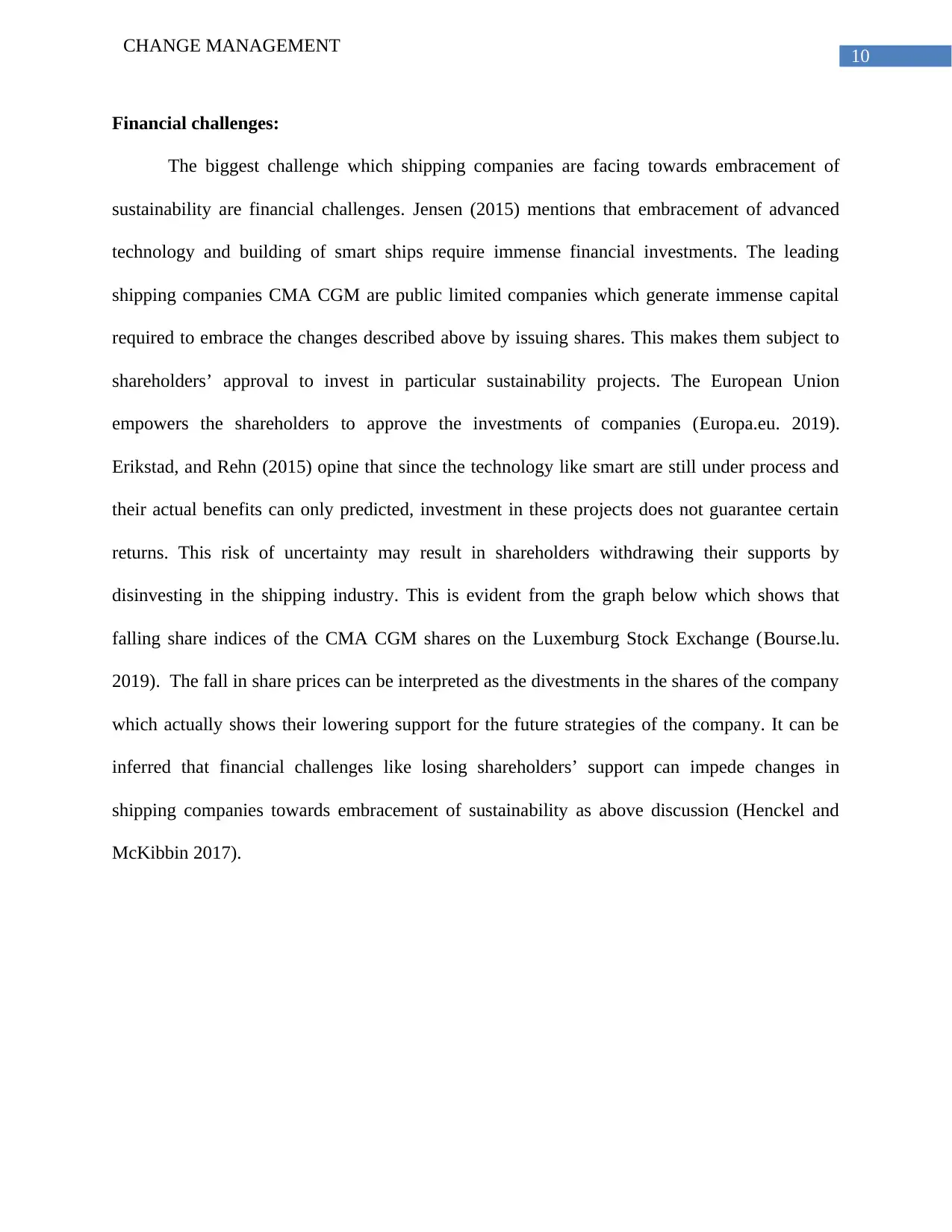
10
CHANGE MANAGEMENT
Financial challenges:
The biggest challenge which shipping companies are facing towards embracement of
sustainability are financial challenges. Jensen (2015) mentions that embracement of advanced
technology and building of smart ships require immense financial investments. The leading
shipping companies CMA CGM are public limited companies which generate immense capital
required to embrace the changes described above by issuing shares. This makes them subject to
shareholders’ approval to invest in particular sustainability projects. The European Union
empowers the shareholders to approve the investments of companies (Europa.eu. 2019).
Erikstad, and Rehn (2015) opine that since the technology like smart are still under process and
their actual benefits can only predicted, investment in these projects does not guarantee certain
returns. This risk of uncertainty may result in shareholders withdrawing their supports by
disinvesting in the shipping industry. This is evident from the graph below which shows that
falling share indices of the CMA CGM shares on the Luxemburg Stock Exchange (Bourse.lu.
2019). The fall in share prices can be interpreted as the divestments in the shares of the company
which actually shows their lowering support for the future strategies of the company. It can be
inferred that financial challenges like losing shareholders’ support can impede changes in
shipping companies towards embracement of sustainability as above discussion (Henckel and
McKibbin 2017).
CHANGE MANAGEMENT
Financial challenges:
The biggest challenge which shipping companies are facing towards embracement of
sustainability are financial challenges. Jensen (2015) mentions that embracement of advanced
technology and building of smart ships require immense financial investments. The leading
shipping companies CMA CGM are public limited companies which generate immense capital
required to embrace the changes described above by issuing shares. This makes them subject to
shareholders’ approval to invest in particular sustainability projects. The European Union
empowers the shareholders to approve the investments of companies (Europa.eu. 2019).
Erikstad, and Rehn (2015) opine that since the technology like smart are still under process and
their actual benefits can only predicted, investment in these projects does not guarantee certain
returns. This risk of uncertainty may result in shareholders withdrawing their supports by
disinvesting in the shipping industry. This is evident from the graph below which shows that
falling share indices of the CMA CGM shares on the Luxemburg Stock Exchange (Bourse.lu.
2019). The fall in share prices can be interpreted as the divestments in the shares of the company
which actually shows their lowering support for the future strategies of the company. It can be
inferred that financial challenges like losing shareholders’ support can impede changes in
shipping companies towards embracement of sustainability as above discussion (Henckel and
McKibbin 2017).
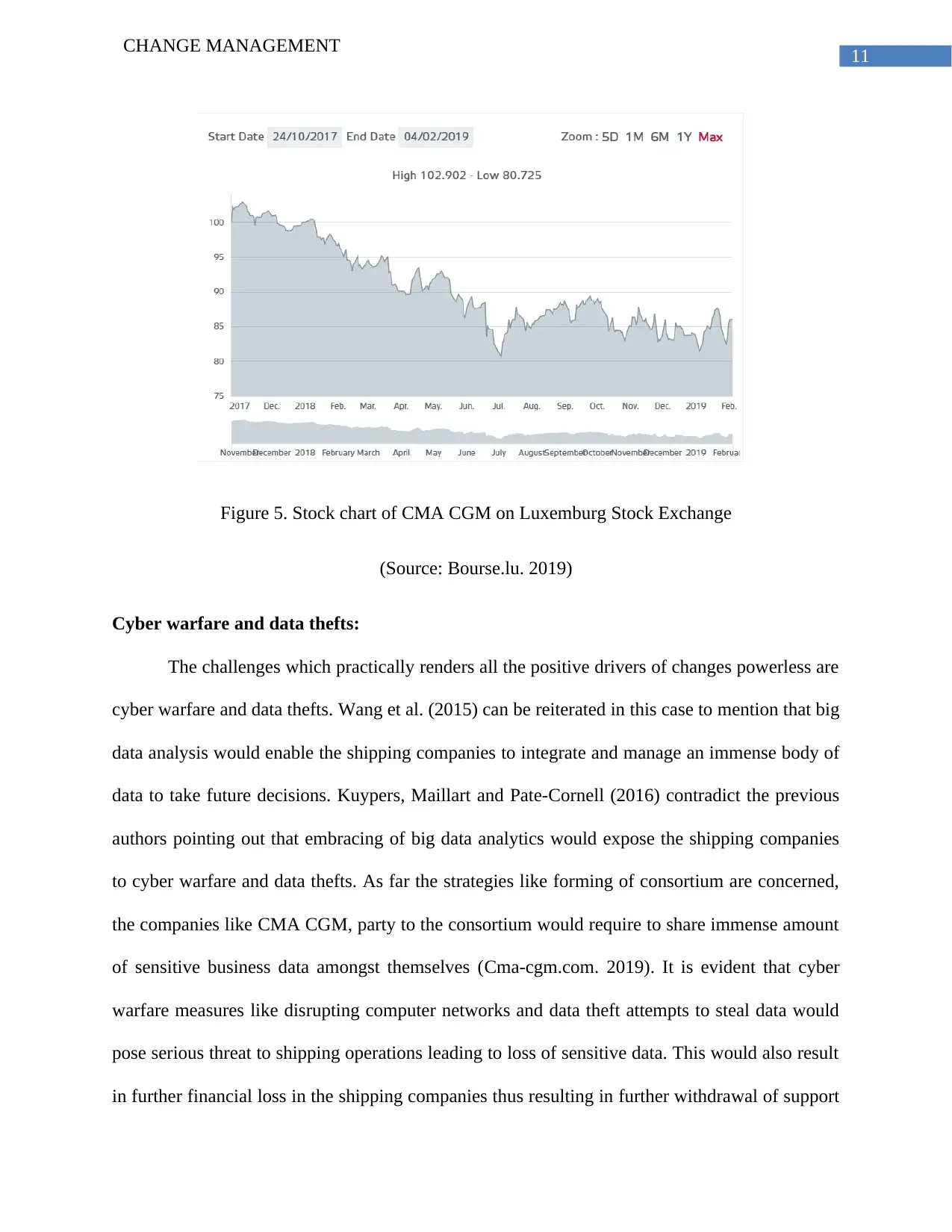
11
CHANGE MANAGEMENT
Figure 5. Stock chart of CMA CGM on Luxemburg Stock Exchange
(Source: Bourse.lu. 2019)
Cyber warfare and data thefts:
The challenges which practically renders all the positive drivers of changes powerless are
cyber warfare and data thefts. Wang et al. (2015) can be reiterated in this case to mention that big
data analysis would enable the shipping companies to integrate and manage an immense body of
data to take future decisions. Kuypers, Maillart and Pate-Cornell (2016) contradict the previous
authors pointing out that embracing of big data analytics would expose the shipping companies
to cyber warfare and data thefts. As far the strategies like forming of consortium are concerned,
the companies like CMA CGM, party to the consortium would require to share immense amount
of sensitive business data amongst themselves (Cma-cgm.com. 2019). It is evident that cyber
warfare measures like disrupting computer networks and data theft attempts to steal data would
pose serious threat to shipping operations leading to loss of sensitive data. This would also result
in further financial loss in the shipping companies thus resulting in further withdrawal of support
CHANGE MANAGEMENT
Figure 5. Stock chart of CMA CGM on Luxemburg Stock Exchange
(Source: Bourse.lu. 2019)
Cyber warfare and data thefts:
The challenges which practically renders all the positive drivers of changes powerless are
cyber warfare and data thefts. Wang et al. (2015) can be reiterated in this case to mention that big
data analysis would enable the shipping companies to integrate and manage an immense body of
data to take future decisions. Kuypers, Maillart and Pate-Cornell (2016) contradict the previous
authors pointing out that embracing of big data analytics would expose the shipping companies
to cyber warfare and data thefts. As far the strategies like forming of consortium are concerned,
the companies like CMA CGM, party to the consortium would require to share immense amount
of sensitive business data amongst themselves (Cma-cgm.com. 2019). It is evident that cyber
warfare measures like disrupting computer networks and data theft attempts to steal data would
pose serious threat to shipping operations leading to loss of sensitive data. This would also result
in further financial loss in the shipping companies thus resulting in further withdrawal of support
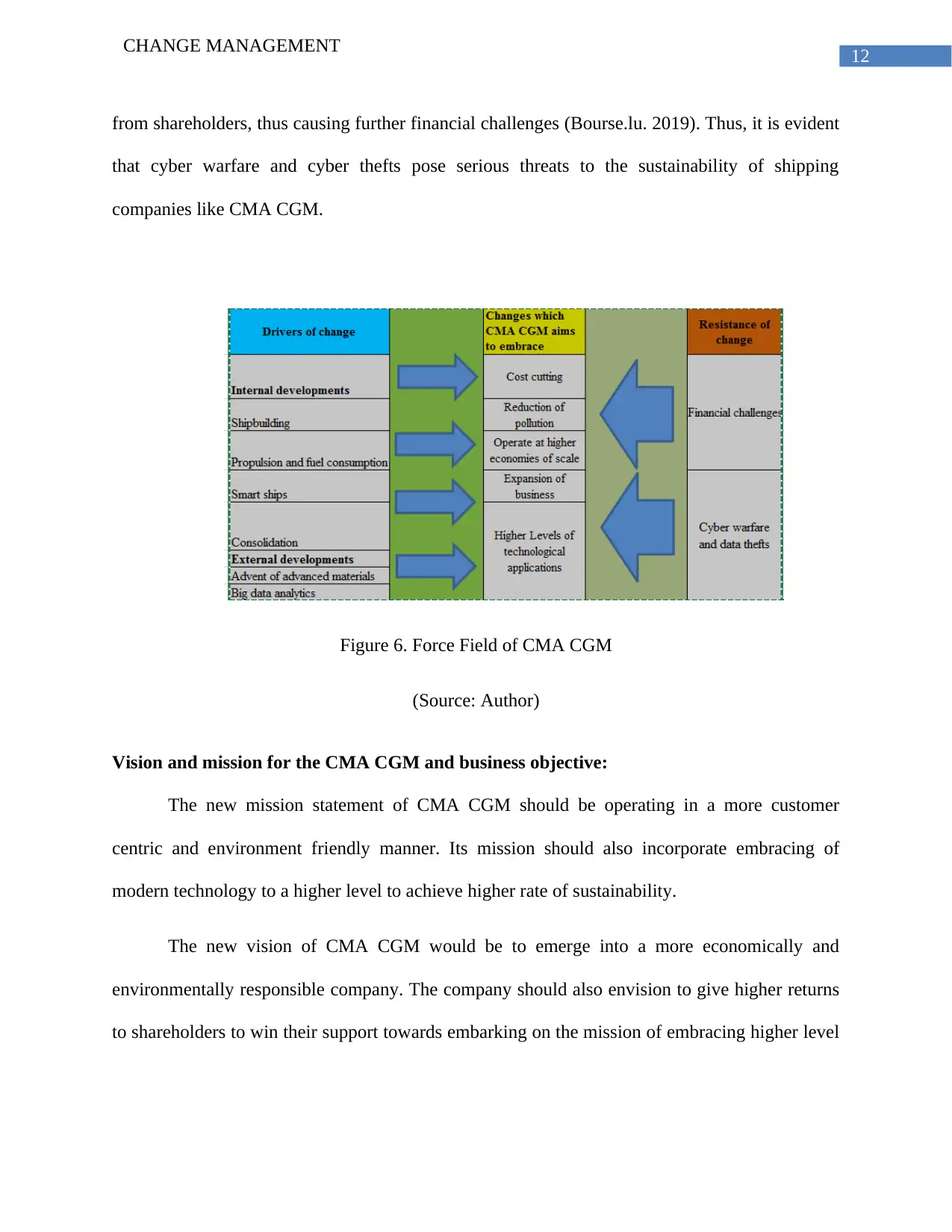
12
CHANGE MANAGEMENT
from shareholders, thus causing further financial challenges (Bourse.lu. 2019). Thus, it is evident
that cyber warfare and cyber thefts pose serious threats to the sustainability of shipping
companies like CMA CGM.
Figure 6. Force Field of CMA CGM
(Source: Author)
Vision and mission for the CMA CGM and business objective:
The new mission statement of CMA CGM should be operating in a more customer
centric and environment friendly manner. Its mission should also incorporate embracing of
modern technology to a higher level to achieve higher rate of sustainability.
The new vision of CMA CGM would be to emerge into a more economically and
environmentally responsible company. The company should also envision to give higher returns
to shareholders to win their support towards embarking on the mission of embracing higher level
CHANGE MANAGEMENT
from shareholders, thus causing further financial challenges (Bourse.lu. 2019). Thus, it is evident
that cyber warfare and cyber thefts pose serious threats to the sustainability of shipping
companies like CMA CGM.
Figure 6. Force Field of CMA CGM
(Source: Author)
Vision and mission for the CMA CGM and business objective:
The new mission statement of CMA CGM should be operating in a more customer
centric and environment friendly manner. Its mission should also incorporate embracing of
modern technology to a higher level to achieve higher rate of sustainability.
The new vision of CMA CGM would be to emerge into a more economically and
environmentally responsible company. The company should also envision to give higher returns
to shareholders to win their support towards embarking on the mission of embracing higher level
Paraphrase This Document
Need a fresh take? Get an instant paraphrase of this document with our AI Paraphraser

13
CHANGE MANAGEMENT
of technology. The new business objective of CMA GCM should be generating higher revenue
and giving higher ROI to investors.
Identify the change agents and propose a suitable structure for the implement of the plan:
The change agents identified which would come into play at CMA CGM to bring about
the changes identified above are apex management and the middle level managers. The
multinational shipping company based in France may also hire counsellors to counsel the
employees.
Create a resource implementation plan:
A suitable change implementation plan would be structured along the line of the
organisational hierarchy of CMA CGM. The change management in CMA CGM should follow
the change management model by Lewin (Hussain et al. 2018).
Change management strategy of CMA CGM following Lewin's Change Model
Activity Nos Activity
particulars Time(months) Responsible
people Comments
1
Apex
managers
hold meeting
with middle
level
managers on
the proposed
changes to
modernise
operations to
gain more
sustainability
6
Apex
management,
middle level
managers
Stage 1:
Unfreeze
2 Finance
department
places the
budget for
approval of
the apex
management
2 CFO, apex
management
CHANGE MANAGEMENT
of technology. The new business objective of CMA GCM should be generating higher revenue
and giving higher ROI to investors.
Identify the change agents and propose a suitable structure for the implement of the plan:
The change agents identified which would come into play at CMA CGM to bring about
the changes identified above are apex management and the middle level managers. The
multinational shipping company based in France may also hire counsellors to counsel the
employees.
Create a resource implementation plan:
A suitable change implementation plan would be structured along the line of the
organisational hierarchy of CMA CGM. The change management in CMA CGM should follow
the change management model by Lewin (Hussain et al. 2018).
Change management strategy of CMA CGM following Lewin's Change Model
Activity Nos Activity
particulars Time(months) Responsible
people Comments
1
Apex
managers
hold meeting
with middle
level
managers on
the proposed
changes to
modernise
operations to
gain more
sustainability
6
Apex
management,
middle level
managers
Stage 1:
Unfreeze
2 Finance
department
places the
budget for
approval of
the apex
management
2 CFO, apex
management
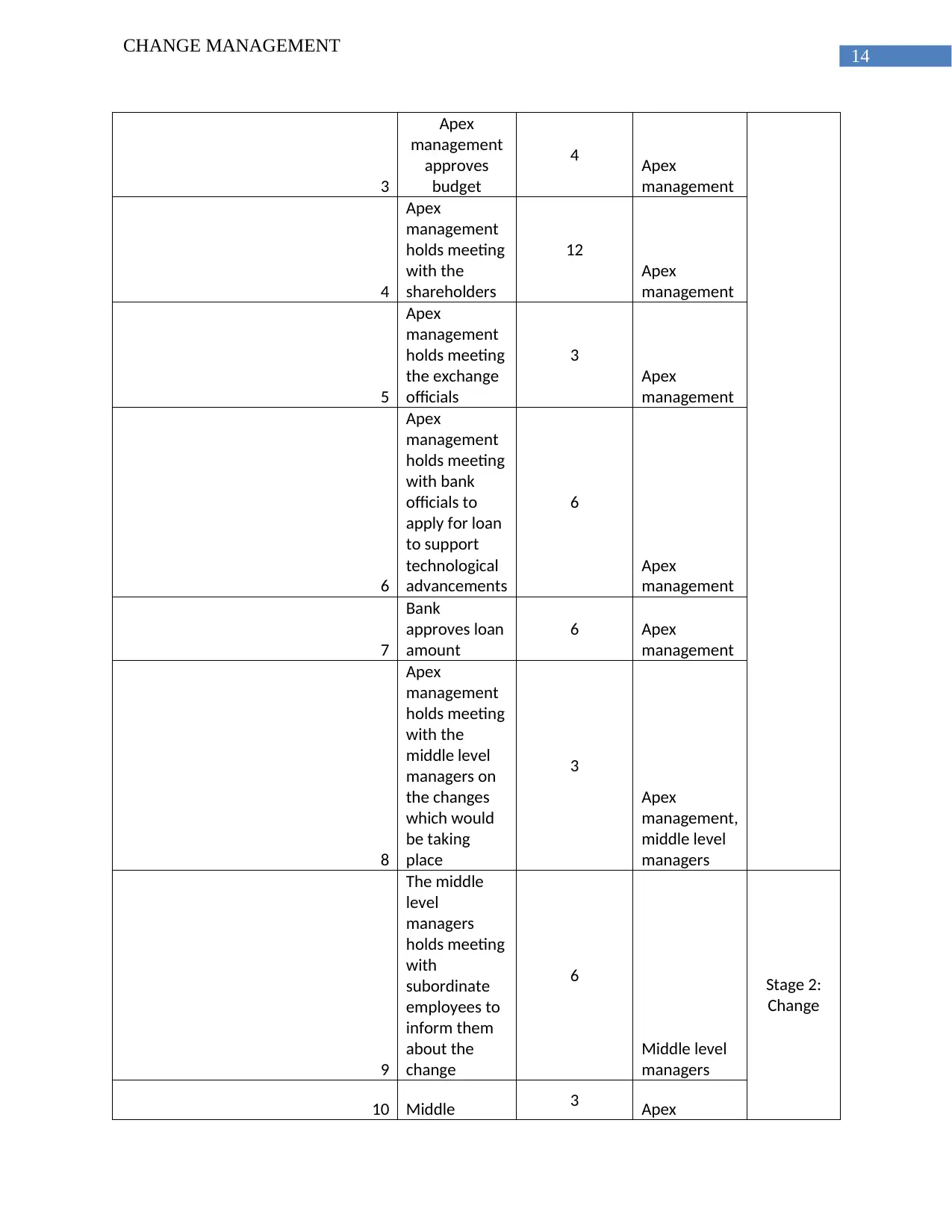
14
CHANGE MANAGEMENT
3
Apex
management
approves
budget
4 Apex
management
4
Apex
management
holds meeting
with the
shareholders
12
Apex
management
5
Apex
management
holds meeting
the exchange
officials
3
Apex
management
6
Apex
management
holds meeting
with bank
officials to
apply for loan
to support
technological
advancements
6
Apex
management
7
Bank
approves loan
amount
6 Apex
management
8
Apex
management
holds meeting
with the
middle level
managers on
the changes
which would
be taking
place
3
Apex
management,
middle level
managers
9
The middle
level
managers
holds meeting
with
subordinate
employees to
inform them
about the
change
6
Middle level
managers
Stage 2:
Change
10 Middle 3 Apex
CHANGE MANAGEMENT
3
Apex
management
approves
budget
4 Apex
management
4
Apex
management
holds meeting
with the
shareholders
12
Apex
management
5
Apex
management
holds meeting
the exchange
officials
3
Apex
management
6
Apex
management
holds meeting
with bank
officials to
apply for loan
to support
technological
advancements
6
Apex
management
7
Bank
approves loan
amount
6 Apex
management
8
Apex
management
holds meeting
with the
middle level
managers on
the changes
which would
be taking
place
3
Apex
management,
middle level
managers
9
The middle
level
managers
holds meeting
with
subordinate
employees to
inform them
about the
change
6
Middle level
managers
Stage 2:
Change
10 Middle 3 Apex
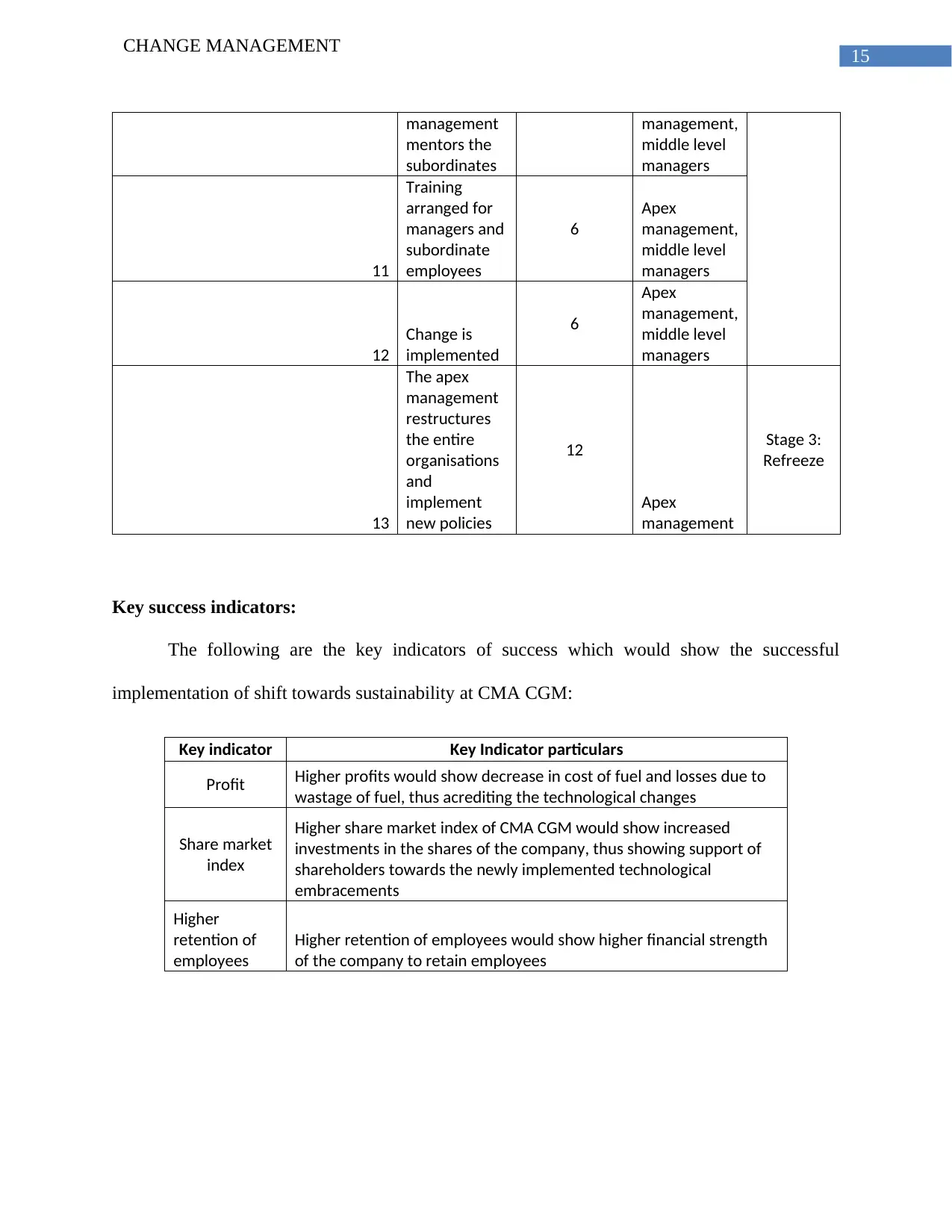
15
CHANGE MANAGEMENT
management
mentors the
subordinates
management,
middle level
managers
11
Training
arranged for
managers and
subordinate
employees
6
Apex
management,
middle level
managers
12
Change is
implemented
6
Apex
management,
middle level
managers
13
The apex
management
restructures
the entire
organisations
and
implement
new policies
12
Apex
management
Stage 3:
Refreeze
Key success indicators:
The following are the key indicators of success which would show the successful
implementation of shift towards sustainability at CMA CGM:
Key indicator Key Indicator particulars
Profit Higher profits would show decrease in cost of fuel and losses due to
wastage of fuel, thus acrediting the technological changes
Share market
index
Higher share market index of CMA CGM would show increased
investments in the shares of the company, thus showing support of
shareholders towards the newly implemented technological
embracements
Higher
retention of
employees
Higher retention of employees would show higher financial strength
of the company to retain employees
CHANGE MANAGEMENT
management
mentors the
subordinates
management,
middle level
managers
11
Training
arranged for
managers and
subordinate
employees
6
Apex
management,
middle level
managers
12
Change is
implemented
6
Apex
management,
middle level
managers
13
The apex
management
restructures
the entire
organisations
and
implement
new policies
12
Apex
management
Stage 3:
Refreeze
Key success indicators:
The following are the key indicators of success which would show the successful
implementation of shift towards sustainability at CMA CGM:
Key indicator Key Indicator particulars
Profit Higher profits would show decrease in cost of fuel and losses due to
wastage of fuel, thus acrediting the technological changes
Share market
index
Higher share market index of CMA CGM would show increased
investments in the shares of the company, thus showing support of
shareholders towards the newly implemented technological
embracements
Higher
retention of
employees
Higher retention of employees would show higher financial strength
of the company to retain employees
Secure Best Marks with AI Grader
Need help grading? Try our AI Grader for instant feedback on your assignments.

16
CHANGE MANAGEMENT
Potential risks during implementation:
The potential risks which CMA CGM would face while implementation of the new
change would the following:
Risk register of CMA CGM
Ris
k
no
Document
control
information
Risk
identifier
Risk
Category
Risk
Descriptio
n
Likelihood
of risks
Impact of the
risks
Risk
response
category
1 Profit and
Loss
statement,
balance
sheets
Falling
profits in
spite of
strong
marketing
strategies
Market
risks
1. Market
risks can
originate
due to
introducti
on of new
products
by existing
competito
rs and/or
entry of
new firms
with
similar
products
into the
shipping
market
2. Market
risk can be
the
outcome
of
introducti
on of low
priced
variants by
local
companies
.
For
example,
strong
competito
rs like
COSCO
Very high
considerin
g the
intense
internatio
nal and
local
competiti
on the
MNC
faces.
1. Fall in
revenue and
losing of
consumers.
(short term
impact)
2. Losing
investors, and
supply chains
due to falling
capacity to
give positive
ROI.(medium
term)
3. Goodwill
risk and losing
of global
market
position (long
term loss)
Strategic
decisions,
marketing
strategies
CHANGE MANAGEMENT
Potential risks during implementation:
The potential risks which CMA CGM would face while implementation of the new
change would the following:
Risk register of CMA CGM
Ris
k
no
Document
control
information
Risk
identifier
Risk
Category
Risk
Descriptio
n
Likelihood
of risks
Impact of the
risks
Risk
response
category
1 Profit and
Loss
statement,
balance
sheets
Falling
profits in
spite of
strong
marketing
strategies
Market
risks
1. Market
risks can
originate
due to
introducti
on of new
products
by existing
competito
rs and/or
entry of
new firms
with
similar
products
into the
shipping
market
2. Market
risk can be
the
outcome
of
introducti
on of low
priced
variants by
local
companies
.
For
example,
strong
competito
rs like
COSCO
Very high
considerin
g the
intense
internatio
nal and
local
competiti
on the
MNC
faces.
1. Fall in
revenue and
losing of
consumers.
(short term
impact)
2. Losing
investors, and
supply chains
due to falling
capacity to
give positive
ROI.(medium
term)
3. Goodwill
risk and losing
of global
market
position (long
term loss)
Strategic
decisions,
marketing
strategies
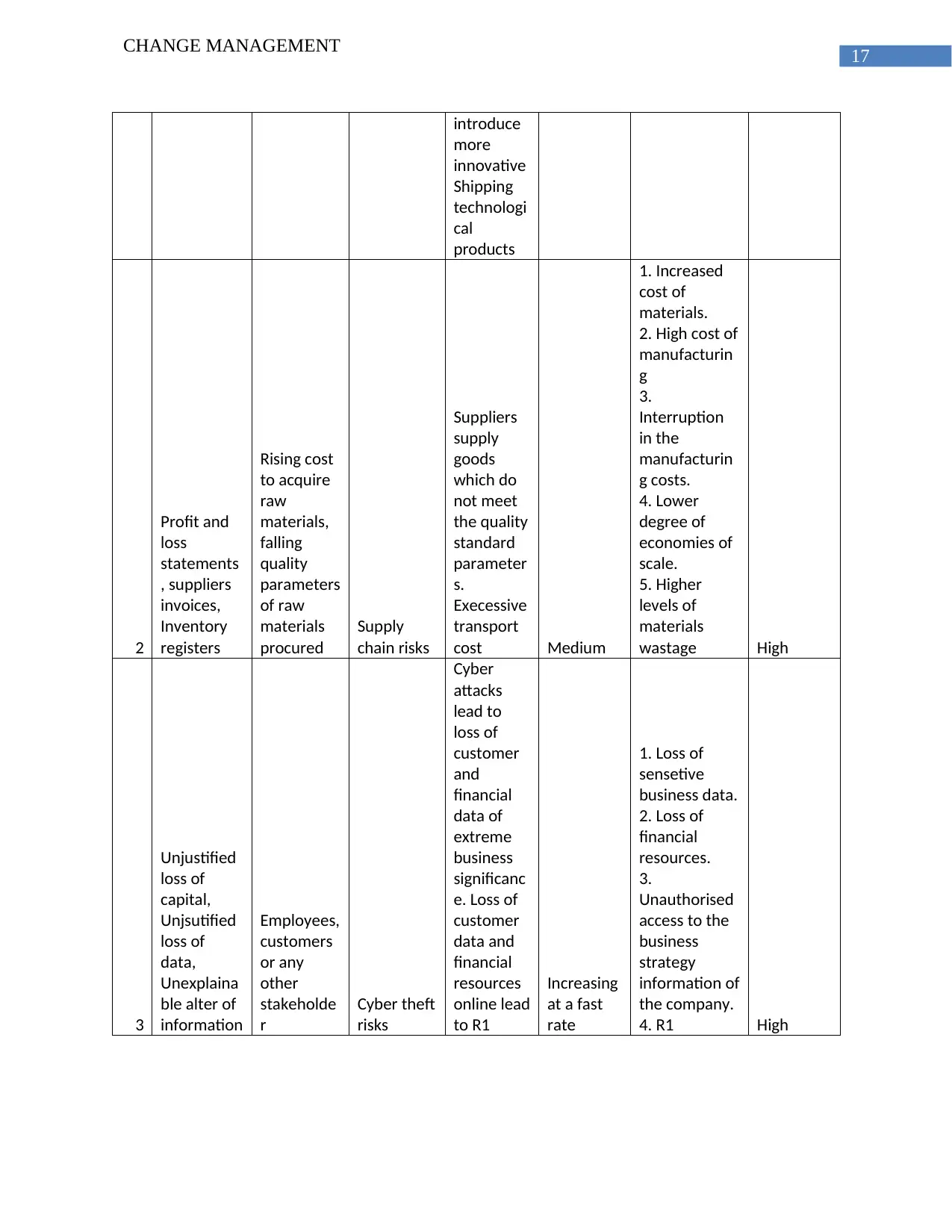
17
CHANGE MANAGEMENT
introduce
more
innovative
Shipping
technologi
cal
products
2
Profit and
loss
statements
, suppliers
invoices,
Inventory
registers
Rising cost
to acquire
raw
materials,
falling
quality
parameters
of raw
materials
procured
Supply
chain risks
Suppliers
supply
goods
which do
not meet
the quality
standard
parameter
s.
Execessive
transport
cost Medium
1. Increased
cost of
materials.
2. High cost of
manufacturin
g
3.
Interruption
in the
manufacturin
g costs.
4. Lower
degree of
economies of
scale.
5. Higher
levels of
materials
wastage High
3
Unjustified
loss of
capital,
Unjsutified
loss of
data,
Unexplaina
ble alter of
information
Employees,
customers
or any
other
stakeholde
r
Cyber theft
risks
Cyber
attacks
lead to
loss of
customer
and
financial
data of
extreme
business
significanc
e. Loss of
customer
data and
financial
resources
online lead
to R1
Increasing
at a fast
rate
1. Loss of
sensetive
business data.
2. Loss of
financial
resources.
3.
Unauthorised
access to the
business
strategy
information of
the company.
4. R1 High
CHANGE MANAGEMENT
introduce
more
innovative
Shipping
technologi
cal
products
2
Profit and
loss
statements
, suppliers
invoices,
Inventory
registers
Rising cost
to acquire
raw
materials,
falling
quality
parameters
of raw
materials
procured
Supply
chain risks
Suppliers
supply
goods
which do
not meet
the quality
standard
parameter
s.
Execessive
transport
cost Medium
1. Increased
cost of
materials.
2. High cost of
manufacturin
g
3.
Interruption
in the
manufacturin
g costs.
4. Lower
degree of
economies of
scale.
5. Higher
levels of
materials
wastage High
3
Unjustified
loss of
capital,
Unjsutified
loss of
data,
Unexplaina
ble alter of
information
Employees,
customers
or any
other
stakeholde
r
Cyber theft
risks
Cyber
attacks
lead to
loss of
customer
and
financial
data of
extreme
business
significanc
e. Loss of
customer
data and
financial
resources
online lead
to R1
Increasing
at a fast
rate
1. Loss of
sensetive
business data.
2. Loss of
financial
resources.
3.
Unauthorised
access to the
business
strategy
information of
the company.
4. R1 High
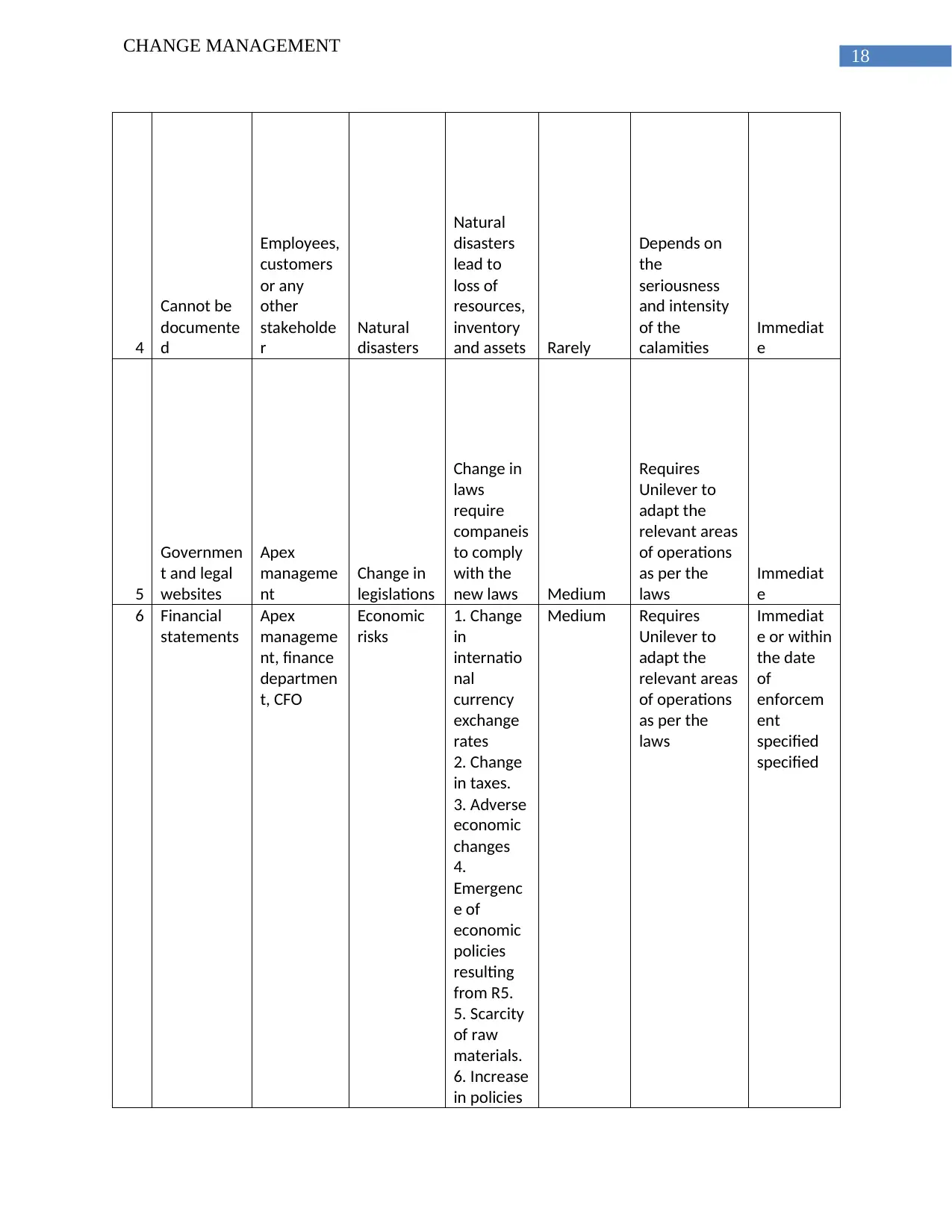
18
CHANGE MANAGEMENT
4
Cannot be
documente
d
Employees,
customers
or any
other
stakeholde
r
Natural
disasters
Natural
disasters
lead to
loss of
resources,
inventory
and assets Rarely
Depends on
the
seriousness
and intensity
of the
calamities
Immediat
e
5
Governmen
t and legal
websites
Apex
manageme
nt
Change in
legislations
Change in
laws
require
companeis
to comply
with the
new laws Medium
Requires
Unilever to
adapt the
relevant areas
of operations
as per the
laws
Immediat
e
6 Financial
statements
Apex
manageme
nt, finance
departmen
t, CFO
Economic
risks
1. Change
in
internatio
nal
currency
exchange
rates
2. Change
in taxes.
3. Adverse
economic
changes
4.
Emergenc
e of
economic
policies
resulting
from R5.
5. Scarcity
of raw
materials.
6. Increase
in policies
Medium Requires
Unilever to
adapt the
relevant areas
of operations
as per the
laws
Immediat
e or within
the date
of
enforcem
ent
specified
specified
CHANGE MANAGEMENT
4
Cannot be
documente
d
Employees,
customers
or any
other
stakeholde
r
Natural
disasters
Natural
disasters
lead to
loss of
resources,
inventory
and assets Rarely
Depends on
the
seriousness
and intensity
of the
calamities
Immediat
e
5
Governmen
t and legal
websites
Apex
manageme
nt
Change in
legislations
Change in
laws
require
companeis
to comply
with the
new laws Medium
Requires
Unilever to
adapt the
relevant areas
of operations
as per the
laws
Immediat
e
6 Financial
statements
Apex
manageme
nt, finance
departmen
t, CFO
Economic
risks
1. Change
in
internatio
nal
currency
exchange
rates
2. Change
in taxes.
3. Adverse
economic
changes
4.
Emergenc
e of
economic
policies
resulting
from R5.
5. Scarcity
of raw
materials.
6. Increase
in policies
Medium Requires
Unilever to
adapt the
relevant areas
of operations
as per the
laws
Immediat
e or within
the date
of
enforcem
ent
specified
specified
Paraphrase This Document
Need a fresh take? Get an instant paraphrase of this document with our AI Paraphraser
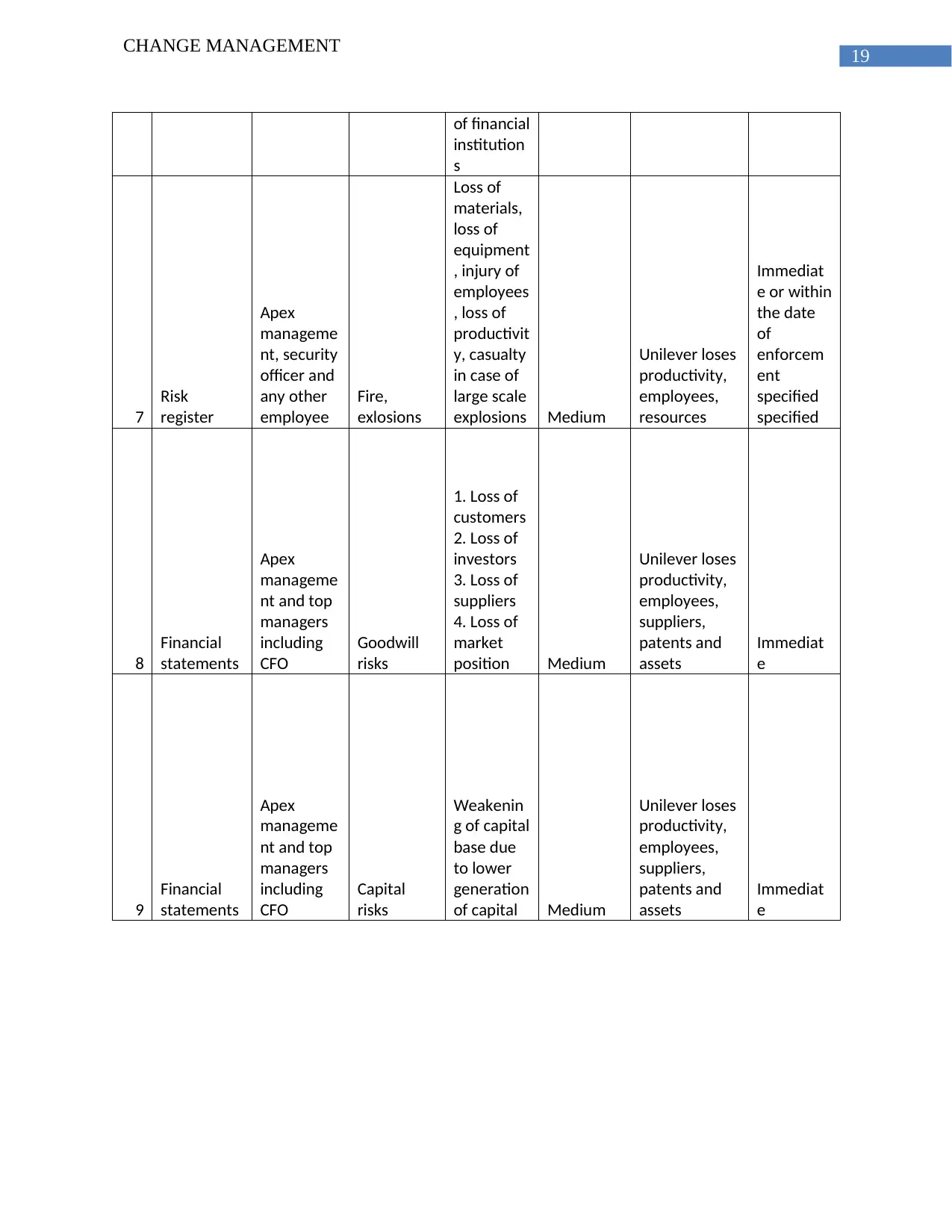
19
CHANGE MANAGEMENT
of financial
institution
s
7
Risk
register
Apex
manageme
nt, security
officer and
any other
employee
Fire,
exlosions
Loss of
materials,
loss of
equipment
, injury of
employees
, loss of
productivit
y, casualty
in case of
large scale
explosions Medium
Unilever loses
productivity,
employees,
resources
Immediat
e or within
the date
of
enforcem
ent
specified
specified
8
Financial
statements
Apex
manageme
nt and top
managers
including
CFO
Goodwill
risks
1. Loss of
customers
2. Loss of
investors
3. Loss of
suppliers
4. Loss of
market
position Medium
Unilever loses
productivity,
employees,
suppliers,
patents and
assets
Immediat
e
9
Financial
statements
Apex
manageme
nt and top
managers
including
CFO
Capital
risks
Weakenin
g of capital
base due
to lower
generation
of capital Medium
Unilever loses
productivity,
employees,
suppliers,
patents and
assets
Immediat
e
CHANGE MANAGEMENT
of financial
institution
s
7
Risk
register
Apex
manageme
nt, security
officer and
any other
employee
Fire,
exlosions
Loss of
materials,
loss of
equipment
, injury of
employees
, loss of
productivit
y, casualty
in case of
large scale
explosions Medium
Unilever loses
productivity,
employees,
resources
Immediat
e or within
the date
of
enforcem
ent
specified
specified
8
Financial
statements
Apex
manageme
nt and top
managers
including
CFO
Goodwill
risks
1. Loss of
customers
2. Loss of
investors
3. Loss of
suppliers
4. Loss of
market
position Medium
Unilever loses
productivity,
employees,
suppliers,
patents and
assets
Immediat
e
9
Financial
statements
Apex
manageme
nt and top
managers
including
CFO
Capital
risks
Weakenin
g of capital
base due
to lower
generation
of capital Medium
Unilever loses
productivity,
employees,
suppliers,
patents and
assets
Immediat
e
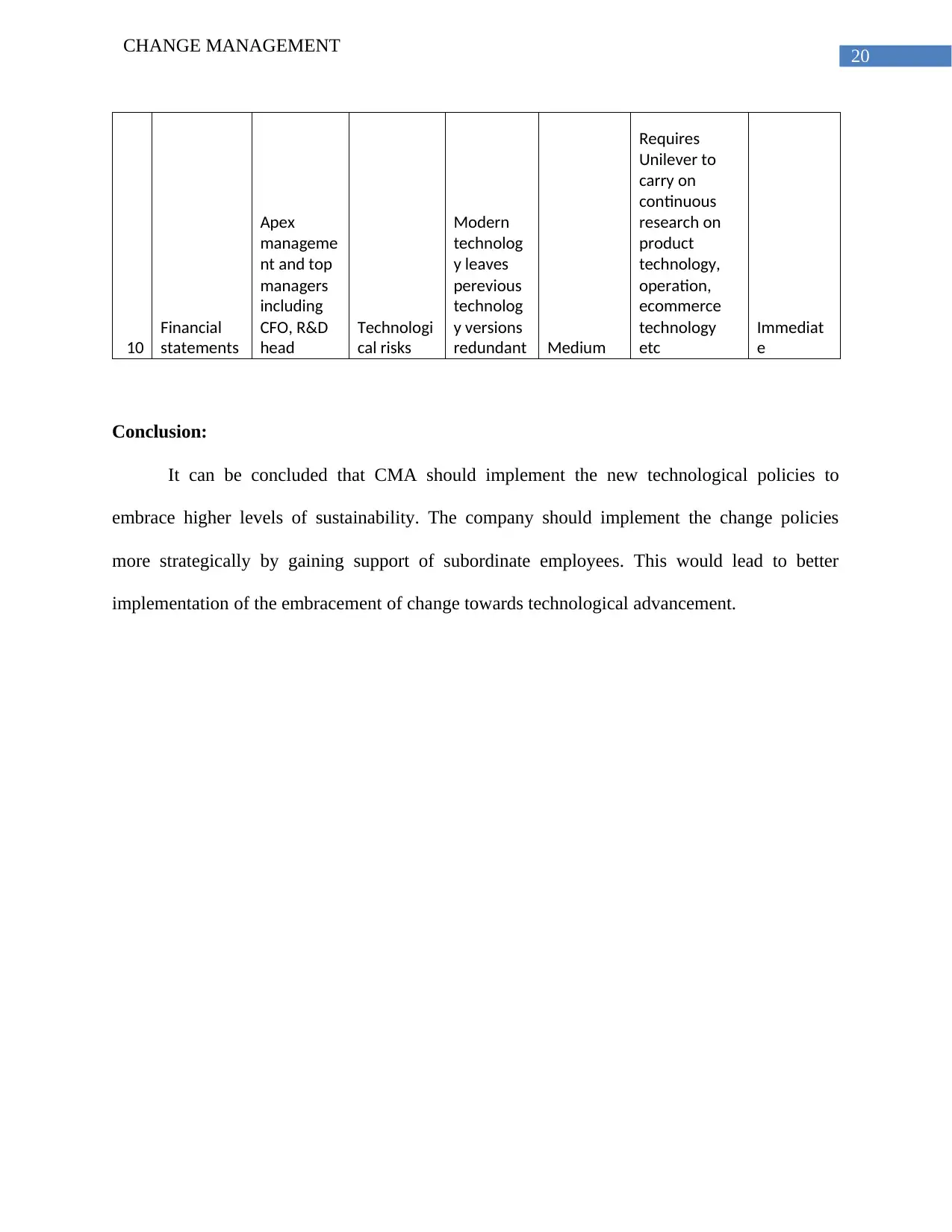
20
CHANGE MANAGEMENT
10
Financial
statements
Apex
manageme
nt and top
managers
including
CFO, R&D
head
Technologi
cal risks
Modern
technolog
y leaves
perevious
technolog
y versions
redundant Medium
Requires
Unilever to
carry on
continuous
research on
product
technology,
operation,
ecommerce
technology
etc
Immediat
e
Conclusion:
It can be concluded that CMA should implement the new technological policies to
embrace higher levels of sustainability. The company should implement the change policies
more strategically by gaining support of subordinate employees. This would lead to better
implementation of the embracement of change towards technological advancement.
CHANGE MANAGEMENT
10
Financial
statements
Apex
manageme
nt and top
managers
including
CFO, R&D
head
Technologi
cal risks
Modern
technolog
y leaves
perevious
technolog
y versions
redundant Medium
Requires
Unilever to
carry on
continuous
research on
product
technology,
operation,
ecommerce
technology
etc
Immediat
e
Conclusion:
It can be concluded that CMA should implement the new technological policies to
embrace higher levels of sustainability. The company should implement the change policies
more strategically by gaining support of subordinate employees. This would lead to better
implementation of the embracement of change towards technological advancement.
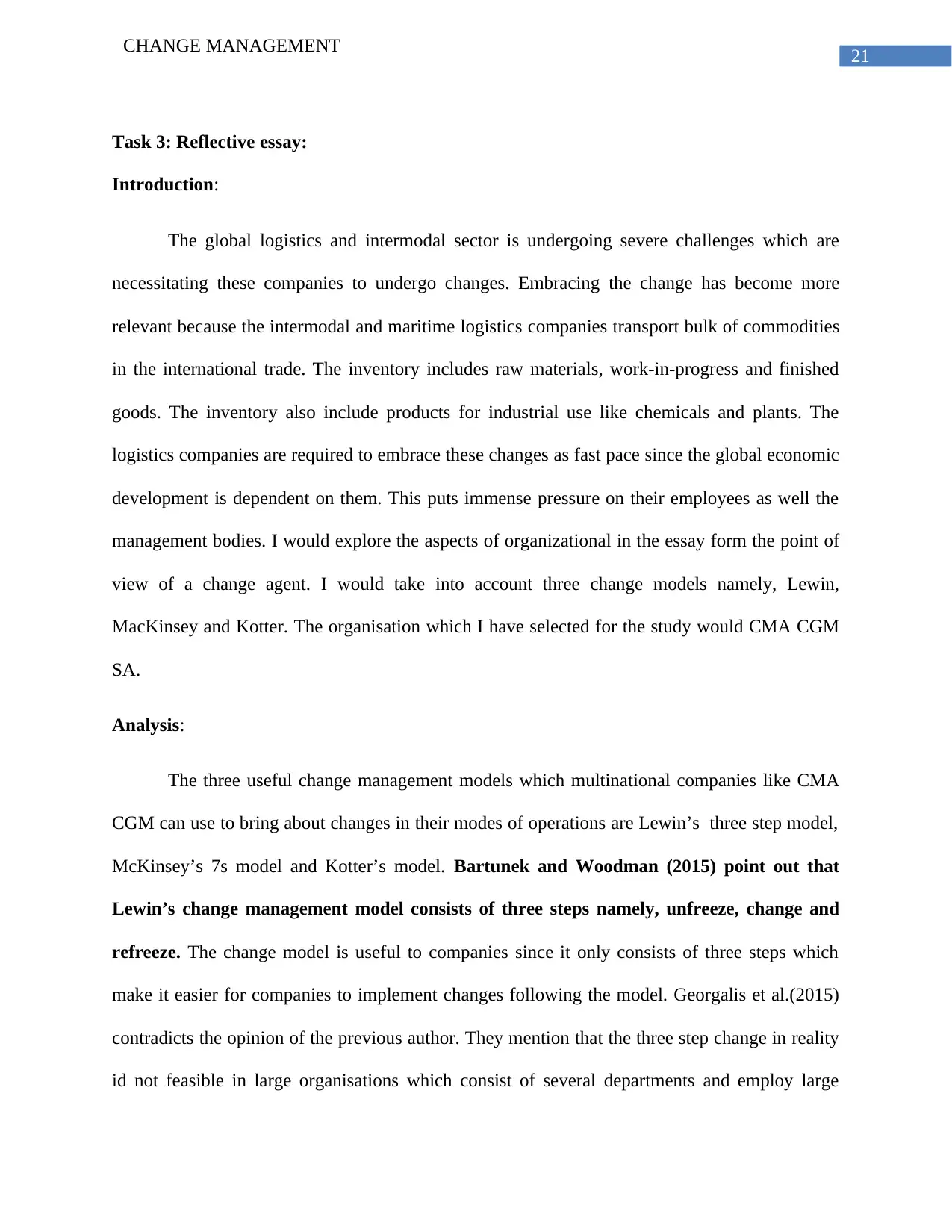
21
CHANGE MANAGEMENT
Task 3: Reflective essay:
Introduction:
The global logistics and intermodal sector is undergoing severe challenges which are
necessitating these companies to undergo changes. Embracing the change has become more
relevant because the intermodal and maritime logistics companies transport bulk of commodities
in the international trade. The inventory includes raw materials, work-in-progress and finished
goods. The inventory also include products for industrial use like chemicals and plants. The
logistics companies are required to embrace these changes as fast pace since the global economic
development is dependent on them. This puts immense pressure on their employees as well the
management bodies. I would explore the aspects of organizational in the essay form the point of
view of a change agent. I would take into account three change models namely, Lewin,
MacKinsey and Kotter. The organisation which I have selected for the study would CMA CGM
SA.
Analysis:
The three useful change management models which multinational companies like CMA
CGM can use to bring about changes in their modes of operations are Lewin’s three step model,
McKinsey’s 7s model and Kotter’s model. Bartunek and Woodman (2015) point out that
Lewin’s change management model consists of three steps namely, unfreeze, change and
refreeze. The change model is useful to companies since it only consists of three steps which
make it easier for companies to implement changes following the model. Georgalis et al.(2015)
contradicts the opinion of the previous author. They mention that the three step change in reality
id not feasible in large organisations which consist of several departments and employ large
CHANGE MANAGEMENT
Task 3: Reflective essay:
Introduction:
The global logistics and intermodal sector is undergoing severe challenges which are
necessitating these companies to undergo changes. Embracing the change has become more
relevant because the intermodal and maritime logistics companies transport bulk of commodities
in the international trade. The inventory includes raw materials, work-in-progress and finished
goods. The inventory also include products for industrial use like chemicals and plants. The
logistics companies are required to embrace these changes as fast pace since the global economic
development is dependent on them. This puts immense pressure on their employees as well the
management bodies. I would explore the aspects of organizational in the essay form the point of
view of a change agent. I would take into account three change models namely, Lewin,
MacKinsey and Kotter. The organisation which I have selected for the study would CMA CGM
SA.
Analysis:
The three useful change management models which multinational companies like CMA
CGM can use to bring about changes in their modes of operations are Lewin’s three step model,
McKinsey’s 7s model and Kotter’s model. Bartunek and Woodman (2015) point out that
Lewin’s change management model consists of three steps namely, unfreeze, change and
refreeze. The change model is useful to companies since it only consists of three steps which
make it easier for companies to implement changes following the model. Georgalis et al.(2015)
contradicts the opinion of the previous author. They mention that the three step change in reality
id not feasible in large organisations which consist of several departments and employ large
Secure Best Marks with AI Grader
Need help grading? Try our AI Grader for instant feedback on your assignments.
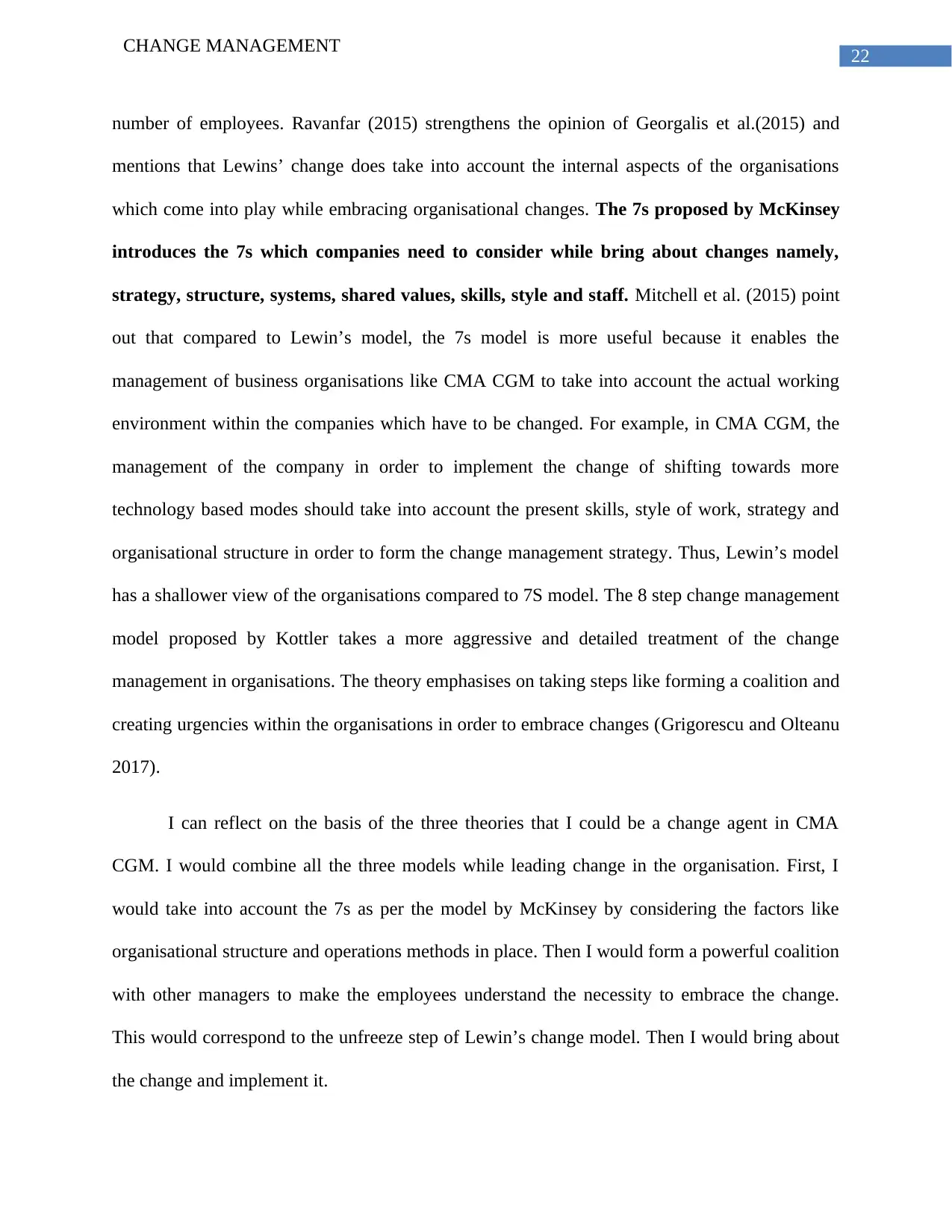
22
CHANGE MANAGEMENT
number of employees. Ravanfar (2015) strengthens the opinion of Georgalis et al.(2015) and
mentions that Lewins’ change does take into account the internal aspects of the organisations
which come into play while embracing organisational changes. The 7s proposed by McKinsey
introduces the 7s which companies need to consider while bring about changes namely,
strategy, structure, systems, shared values, skills, style and staff. Mitchell et al. (2015) point
out that compared to Lewin’s model, the 7s model is more useful because it enables the
management of business organisations like CMA CGM to take into account the actual working
environment within the companies which have to be changed. For example, in CMA CGM, the
management of the company in order to implement the change of shifting towards more
technology based modes should take into account the present skills, style of work, strategy and
organisational structure in order to form the change management strategy. Thus, Lewin’s model
has a shallower view of the organisations compared to 7S model. The 8 step change management
model proposed by Kottler takes a more aggressive and detailed treatment of the change
management in organisations. The theory emphasises on taking steps like forming a coalition and
creating urgencies within the organisations in order to embrace changes (Grigorescu and Olteanu
2017).
I can reflect on the basis of the three theories that I could be a change agent in CMA
CGM. I would combine all the three models while leading change in the organisation. First, I
would take into account the 7s as per the model by McKinsey by considering the factors like
organisational structure and operations methods in place. Then I would form a powerful coalition
with other managers to make the employees understand the necessity to embrace the change.
This would correspond to the unfreeze step of Lewin’s change model. Then I would bring about
the change and implement it.
CHANGE MANAGEMENT
number of employees. Ravanfar (2015) strengthens the opinion of Georgalis et al.(2015) and
mentions that Lewins’ change does take into account the internal aspects of the organisations
which come into play while embracing organisational changes. The 7s proposed by McKinsey
introduces the 7s which companies need to consider while bring about changes namely,
strategy, structure, systems, shared values, skills, style and staff. Mitchell et al. (2015) point
out that compared to Lewin’s model, the 7s model is more useful because it enables the
management of business organisations like CMA CGM to take into account the actual working
environment within the companies which have to be changed. For example, in CMA CGM, the
management of the company in order to implement the change of shifting towards more
technology based modes should take into account the present skills, style of work, strategy and
organisational structure in order to form the change management strategy. Thus, Lewin’s model
has a shallower view of the organisations compared to 7S model. The 8 step change management
model proposed by Kottler takes a more aggressive and detailed treatment of the change
management in organisations. The theory emphasises on taking steps like forming a coalition and
creating urgencies within the organisations in order to embrace changes (Grigorescu and Olteanu
2017).
I can reflect on the basis of the three theories that I could be a change agent in CMA
CGM. I would combine all the three models while leading change in the organisation. First, I
would take into account the 7s as per the model by McKinsey by considering the factors like
organisational structure and operations methods in place. Then I would form a powerful coalition
with other managers to make the employees understand the necessity to embrace the change.
This would correspond to the unfreeze step of Lewin’s change model. Then I would bring about
the change and implement it.
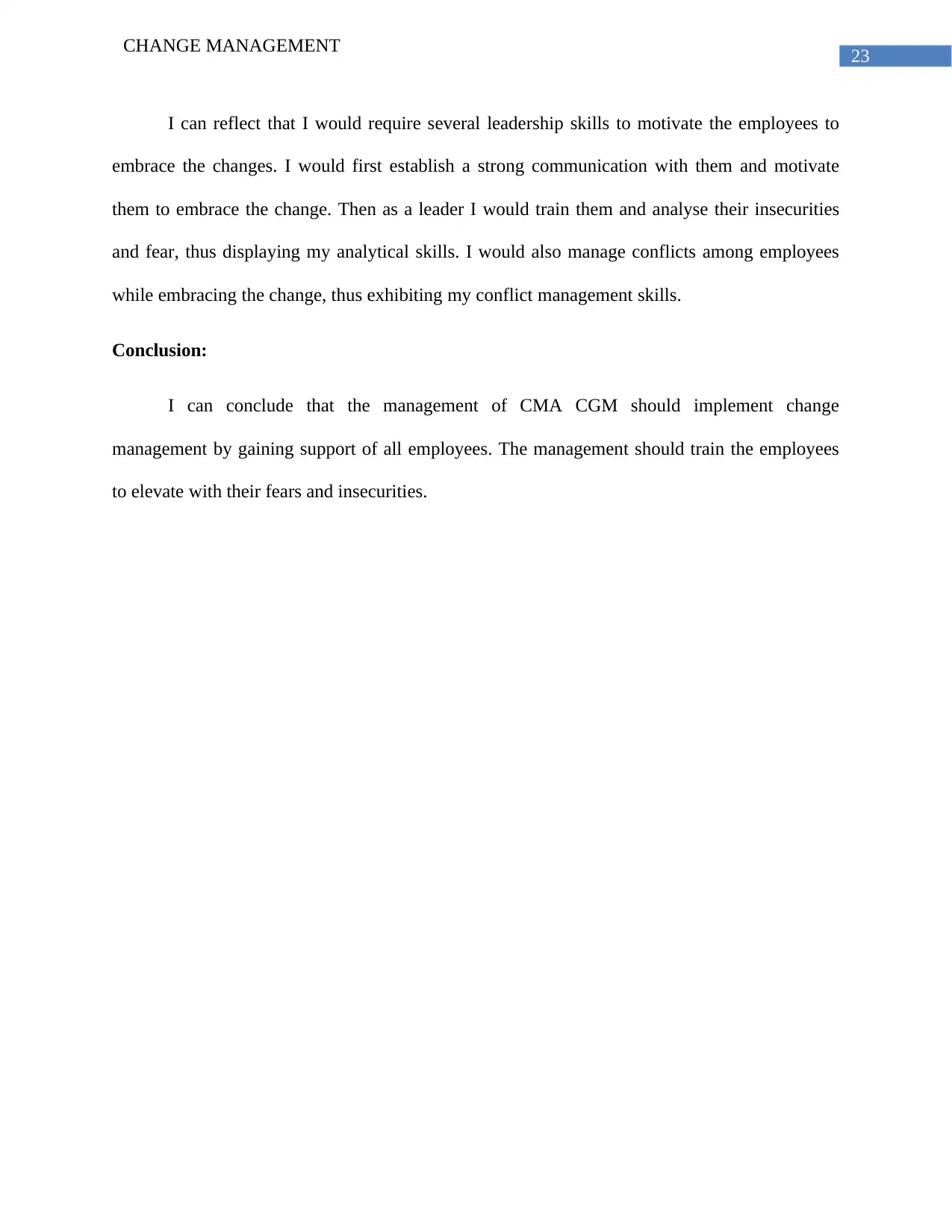
23
CHANGE MANAGEMENT
I can reflect that I would require several leadership skills to motivate the employees to
embrace the changes. I would first establish a strong communication with them and motivate
them to embrace the change. Then as a leader I would train them and analyse their insecurities
and fear, thus displaying my analytical skills. I would also manage conflicts among employees
while embracing the change, thus exhibiting my conflict management skills.
Conclusion:
I can conclude that the management of CMA CGM should implement change
management by gaining support of all employees. The management should train the employees
to elevate with their fears and insecurities.
CHANGE MANAGEMENT
I can reflect that I would require several leadership skills to motivate the employees to
embrace the changes. I would first establish a strong communication with them and motivate
them to embrace the change. Then as a leader I would train them and analyse their insecurities
and fear, thus displaying my analytical skills. I would also manage conflicts among employees
while embracing the change, thus exhibiting my conflict management skills.
Conclusion:
I can conclude that the management of CMA CGM should implement change
management by gaining support of all employees. The management should train the employees
to elevate with their fears and insecurities.
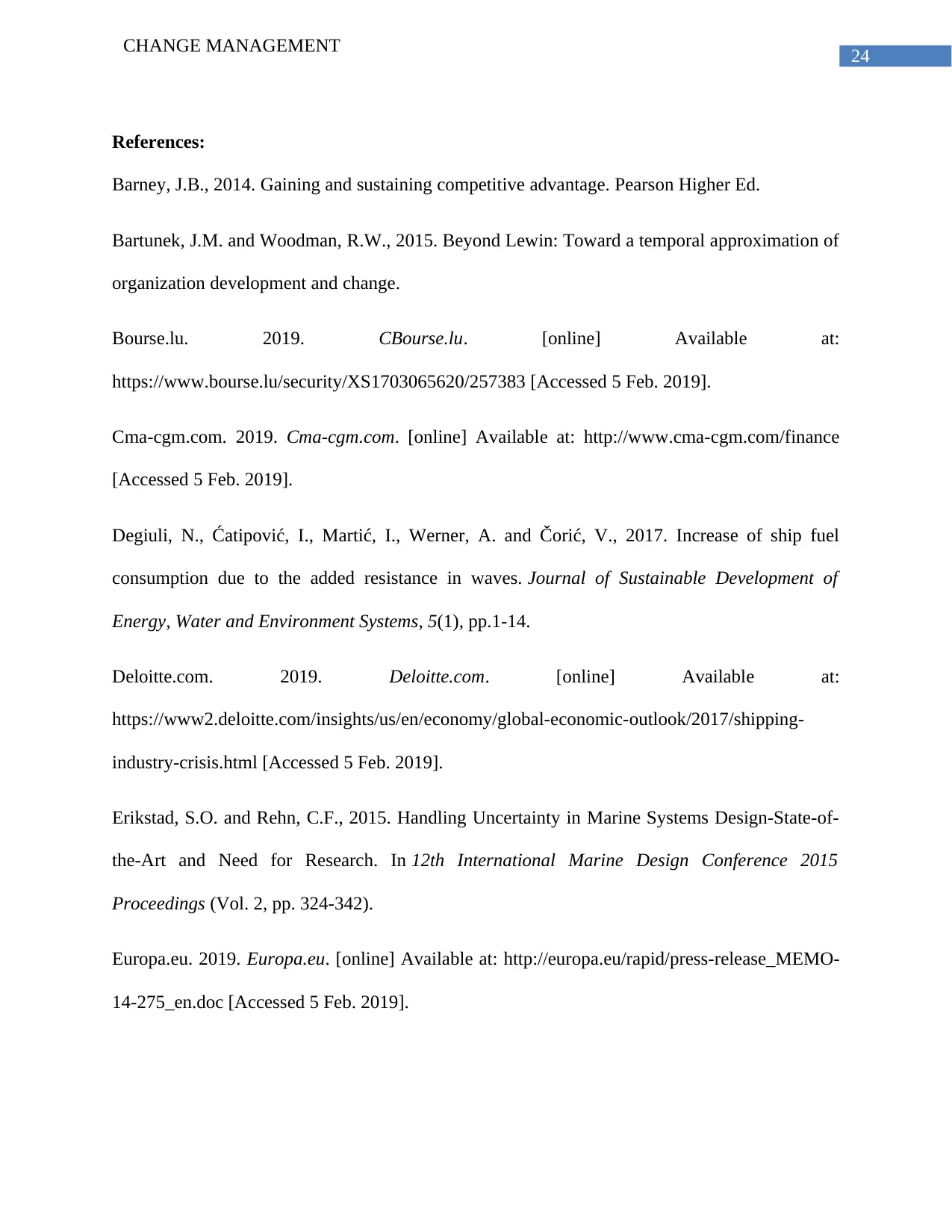
24
CHANGE MANAGEMENT
References:
Barney, J.B., 2014. Gaining and sustaining competitive advantage. Pearson Higher Ed.
Bartunek, J.M. and Woodman, R.W., 2015. Beyond Lewin: Toward a temporal approximation of
organization development and change.
Bourse.lu. 2019. CBourse.lu. [online] Available at:
https://www.bourse.lu/security/XS1703065620/257383 [Accessed 5 Feb. 2019].
Cma-cgm.com. 2019. Cma-cgm.com. [online] Available at: http://www.cma-cgm.com/finance
[Accessed 5 Feb. 2019].
Degiuli, N., Ćatipović, I., Martić, I., Werner, A. and Čorić, V., 2017. Increase of ship fuel
consumption due to the added resistance in waves. Journal of Sustainable Development of
Energy, Water and Environment Systems, 5(1), pp.1-14.
Deloitte.com. 2019. Deloitte.com. [online] Available at:
https://www2.deloitte.com/insights/us/en/economy/global-economic-outlook/2017/shipping-
industry-crisis.html [Accessed 5 Feb. 2019].
Erikstad, S.O. and Rehn, C.F., 2015. Handling Uncertainty in Marine Systems Design-State-of-
the-Art and Need for Research. In 12th International Marine Design Conference 2015
Proceedings (Vol. 2, pp. 324-342).
Europa.eu. 2019. Europa.eu. [online] Available at: http://europa.eu/rapid/press-release_MEMO-
14-275_en.doc [Accessed 5 Feb. 2019].
CHANGE MANAGEMENT
References:
Barney, J.B., 2014. Gaining and sustaining competitive advantage. Pearson Higher Ed.
Bartunek, J.M. and Woodman, R.W., 2015. Beyond Lewin: Toward a temporal approximation of
organization development and change.
Bourse.lu. 2019. CBourse.lu. [online] Available at:
https://www.bourse.lu/security/XS1703065620/257383 [Accessed 5 Feb. 2019].
Cma-cgm.com. 2019. Cma-cgm.com. [online] Available at: http://www.cma-cgm.com/finance
[Accessed 5 Feb. 2019].
Degiuli, N., Ćatipović, I., Martić, I., Werner, A. and Čorić, V., 2017. Increase of ship fuel
consumption due to the added resistance in waves. Journal of Sustainable Development of
Energy, Water and Environment Systems, 5(1), pp.1-14.
Deloitte.com. 2019. Deloitte.com. [online] Available at:
https://www2.deloitte.com/insights/us/en/economy/global-economic-outlook/2017/shipping-
industry-crisis.html [Accessed 5 Feb. 2019].
Erikstad, S.O. and Rehn, C.F., 2015. Handling Uncertainty in Marine Systems Design-State-of-
the-Art and Need for Research. In 12th International Marine Design Conference 2015
Proceedings (Vol. 2, pp. 324-342).
Europa.eu. 2019. Europa.eu. [online] Available at: http://europa.eu/rapid/press-release_MEMO-
14-275_en.doc [Accessed 5 Feb. 2019].
Paraphrase This Document
Need a fresh take? Get an instant paraphrase of this document with our AI Paraphraser

25
CHANGE MANAGEMENT
Georgalis, J., Samaratunge, R., Kimberley, N. and Lu, Y., 2015. Change process characteristics
and resistance to organisational change: The role of employee perceptions of justice. Australian
Journal of Management, 40(1), pp.89-113.
Grigorescu, A. and Olteanu, M.L., 2017. Quantum Model Of Change Management For
Undergraduate Education–European Perspective. In Proceedings of the INTERNATIONAL
MANAGEMENT CONFERENCE (Vol. 11, No. 1, pp. 400-413). Faculty of Management,
Academy of Economic Studies, Bucharest, Romania.
Henckel, T. and McKibbin, W., 2017. The economics of infrastructure in a globalized world:
issues, lessons and future challenges. Journal of Infrastructure, Policy and Development, 1(2),
pp.254-272.
Hussain, S.T., Lei, S., Akram, T., Haider, M.J., Hussain, S.H. and Ali, M., 2018. Kurt Lewin's
change model: A critical review of the role of leadership and employee involvement in
organizational change. Journal of Innovation & Knowledge, 3(3), pp.123-127.
Ics-shipping.org. 2019. Ics-shipping.org. [online] Available at:
http://www.ics-shipping.org/shipping-facts/shipping-and-world-trade/predicted-increases-in-
world-seaborne-trade-gdp-and-population [Accessed 24 Jan. 2019].
Jensen, L., 2015. Challenges in maritime cyber-resilience. Technology Innovation Management
Review, 5(4), p.35.
Kuypers, M.A., Maillart, T. and Pate-Cornell, E., 2016. An empirical analysis of cyber security
incidents at a large organization. Department of Management Science and Engineering, Stanford
University, School of Information, UC Berkeley, http://fsi. stanford.
edu/sites/default/files/kuypersweis_v7. pdf, accessed July, 30.
CHANGE MANAGEMENT
Georgalis, J., Samaratunge, R., Kimberley, N. and Lu, Y., 2015. Change process characteristics
and resistance to organisational change: The role of employee perceptions of justice. Australian
Journal of Management, 40(1), pp.89-113.
Grigorescu, A. and Olteanu, M.L., 2017. Quantum Model Of Change Management For
Undergraduate Education–European Perspective. In Proceedings of the INTERNATIONAL
MANAGEMENT CONFERENCE (Vol. 11, No. 1, pp. 400-413). Faculty of Management,
Academy of Economic Studies, Bucharest, Romania.
Henckel, T. and McKibbin, W., 2017. The economics of infrastructure in a globalized world:
issues, lessons and future challenges. Journal of Infrastructure, Policy and Development, 1(2),
pp.254-272.
Hussain, S.T., Lei, S., Akram, T., Haider, M.J., Hussain, S.H. and Ali, M., 2018. Kurt Lewin's
change model: A critical review of the role of leadership and employee involvement in
organizational change. Journal of Innovation & Knowledge, 3(3), pp.123-127.
Ics-shipping.org. 2019. Ics-shipping.org. [online] Available at:
http://www.ics-shipping.org/shipping-facts/shipping-and-world-trade/predicted-increases-in-
world-seaborne-trade-gdp-and-population [Accessed 24 Jan. 2019].
Jensen, L., 2015. Challenges in maritime cyber-resilience. Technology Innovation Management
Review, 5(4), p.35.
Kuypers, M.A., Maillart, T. and Pate-Cornell, E., 2016. An empirical analysis of cyber security
incidents at a large organization. Department of Management Science and Engineering, Stanford
University, School of Information, UC Berkeley, http://fsi. stanford.
edu/sites/default/files/kuypersweis_v7. pdf, accessed July, 30.

26
CHANGE MANAGEMENT
Lee, H., Aydin, N., Choi, Y., Lekhavat, S. and Irani, Z., 2018. A decision support system for
vessel speed decision in maritime logistics using weather archive big data. Computers &
Operations Research, 98, pp.330-342.
Marin, D.I.T.K., 2016. Research Article A Preliminary Study of Fixtureless Shipbuilding
Practice.
Mitchell, B.C., Fredendall, L.D. and Cantrell, R.S., 2015. Using McKinsey’s 7 S Model to
Empirically Examine Organizational Effectiveness among the NBA Teams. International
Journal of Management & Human Resources, 3(1).
Mpa.gov.sg. 2019. Mpa.gov.sg. [online] Available at:
https://www.mpa.gov.sg/web/wcm/connect/www/77bb6866-4c2b-4ba5-9249-1203a943852a/
Presentation+-+James+Forsdyke.pdf?MOD=AJPERES [Accessed 5 Feb. 2019].
Parker, R.W. and Tyedmers, P.H., 2015. Fuel consumption of global fishing fleets: current
understanding and knowledge gaps. Fish and Fisheries, 16(4), pp.684-696.
Piesing, M. 2019. Inews.co.uk. [online] Inews.co.uk. Available at: https://inews.co.uk/news/long-
reads/cargo-container-shipping-carbon-pollution/ [Accessed 24 Jan. 2019].
Pigni, F., Piccoli, G. and Watson, R., 2016. Digital Data Streams: Creating value from the real-
time flow of big data. California Management Review, 58(3), pp.5-25.
Ravanfar, M.M., 2015. Analyzing Organizational Structure based on 7s model of
McKinsey. Global Journal of Management And Business Research.
Shmgroup.com. 2019. Shmgroup.com. [online] Available at: http://www.shmgroup.com/blog/8-
trends-that-will-drive-the-shipping-industry-in-2019/ [Accessed 5 Feb. 2019].
CHANGE MANAGEMENT
Lee, H., Aydin, N., Choi, Y., Lekhavat, S. and Irani, Z., 2018. A decision support system for
vessel speed decision in maritime logistics using weather archive big data. Computers &
Operations Research, 98, pp.330-342.
Marin, D.I.T.K., 2016. Research Article A Preliminary Study of Fixtureless Shipbuilding
Practice.
Mitchell, B.C., Fredendall, L.D. and Cantrell, R.S., 2015. Using McKinsey’s 7 S Model to
Empirically Examine Organizational Effectiveness among the NBA Teams. International
Journal of Management & Human Resources, 3(1).
Mpa.gov.sg. 2019. Mpa.gov.sg. [online] Available at:
https://www.mpa.gov.sg/web/wcm/connect/www/77bb6866-4c2b-4ba5-9249-1203a943852a/
Presentation+-+James+Forsdyke.pdf?MOD=AJPERES [Accessed 5 Feb. 2019].
Parker, R.W. and Tyedmers, P.H., 2015. Fuel consumption of global fishing fleets: current
understanding and knowledge gaps. Fish and Fisheries, 16(4), pp.684-696.
Piesing, M. 2019. Inews.co.uk. [online] Inews.co.uk. Available at: https://inews.co.uk/news/long-
reads/cargo-container-shipping-carbon-pollution/ [Accessed 24 Jan. 2019].
Pigni, F., Piccoli, G. and Watson, R., 2016. Digital Data Streams: Creating value from the real-
time flow of big data. California Management Review, 58(3), pp.5-25.
Ravanfar, M.M., 2015. Analyzing Organizational Structure based on 7s model of
McKinsey. Global Journal of Management And Business Research.
Shmgroup.com. 2019. Shmgroup.com. [online] Available at: http://www.shmgroup.com/blog/8-
trends-that-will-drive-the-shipping-industry-in-2019/ [Accessed 5 Feb. 2019].
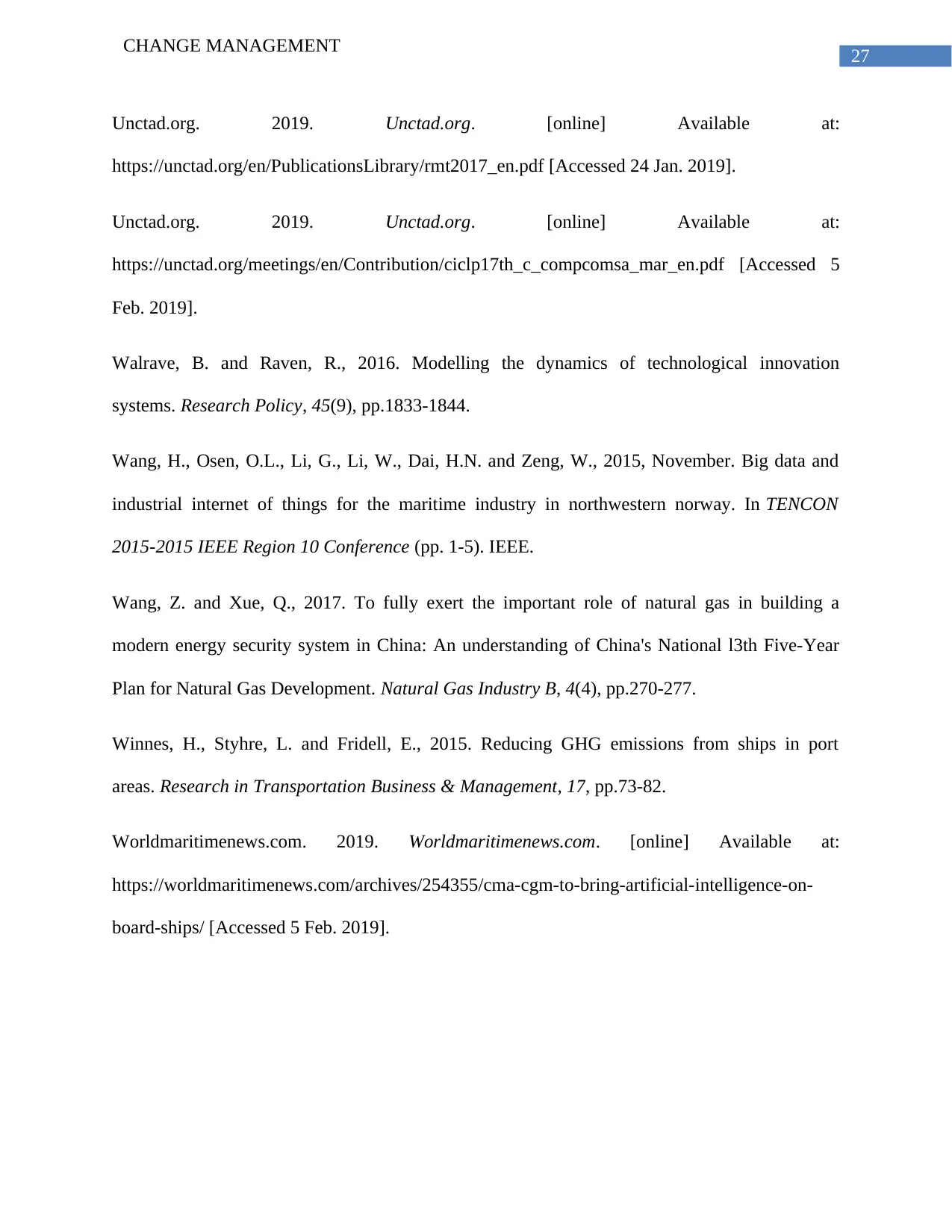
27
CHANGE MANAGEMENT
Unctad.org. 2019. Unctad.org. [online] Available at:
https://unctad.org/en/PublicationsLibrary/rmt2017_en.pdf [Accessed 24 Jan. 2019].
Unctad.org. 2019. Unctad.org. [online] Available at:
https://unctad.org/meetings/en/Contribution/ciclp17th_c_compcomsa_mar_en.pdf [Accessed 5
Feb. 2019].
Walrave, B. and Raven, R., 2016. Modelling the dynamics of technological innovation
systems. Research Policy, 45(9), pp.1833-1844.
Wang, H., Osen, O.L., Li, G., Li, W., Dai, H.N. and Zeng, W., 2015, November. Big data and
industrial internet of things for the maritime industry in northwestern norway. In TENCON
2015-2015 IEEE Region 10 Conference (pp. 1-5). IEEE.
Wang, Z. and Xue, Q., 2017. To fully exert the important role of natural gas in building a
modern energy security system in China: An understanding of China's National l3th Five-Year
Plan for Natural Gas Development. Natural Gas Industry B, 4(4), pp.270-277.
Winnes, H., Styhre, L. and Fridell, E., 2015. Reducing GHG emissions from ships in port
areas. Research in Transportation Business & Management, 17, pp.73-82.
Worldmaritimenews.com. 2019. Worldmaritimenews.com. [online] Available at:
https://worldmaritimenews.com/archives/254355/cma-cgm-to-bring-artificial-intelligence-on-
board-ships/ [Accessed 5 Feb. 2019].
CHANGE MANAGEMENT
Unctad.org. 2019. Unctad.org. [online] Available at:
https://unctad.org/en/PublicationsLibrary/rmt2017_en.pdf [Accessed 24 Jan. 2019].
Unctad.org. 2019. Unctad.org. [online] Available at:
https://unctad.org/meetings/en/Contribution/ciclp17th_c_compcomsa_mar_en.pdf [Accessed 5
Feb. 2019].
Walrave, B. and Raven, R., 2016. Modelling the dynamics of technological innovation
systems. Research Policy, 45(9), pp.1833-1844.
Wang, H., Osen, O.L., Li, G., Li, W., Dai, H.N. and Zeng, W., 2015, November. Big data and
industrial internet of things for the maritime industry in northwestern norway. In TENCON
2015-2015 IEEE Region 10 Conference (pp. 1-5). IEEE.
Wang, Z. and Xue, Q., 2017. To fully exert the important role of natural gas in building a
modern energy security system in China: An understanding of China's National l3th Five-Year
Plan for Natural Gas Development. Natural Gas Industry B, 4(4), pp.270-277.
Winnes, H., Styhre, L. and Fridell, E., 2015. Reducing GHG emissions from ships in port
areas. Research in Transportation Business & Management, 17, pp.73-82.
Worldmaritimenews.com. 2019. Worldmaritimenews.com. [online] Available at:
https://worldmaritimenews.com/archives/254355/cma-cgm-to-bring-artificial-intelligence-on-
board-ships/ [Accessed 5 Feb. 2019].
1 out of 28
Your All-in-One AI-Powered Toolkit for Academic Success.
+13062052269
info@desklib.com
Available 24*7 on WhatsApp / Email
![[object Object]](/_next/static/media/star-bottom.7253800d.svg)
Unlock your academic potential
© 2024 | Zucol Services PVT LTD | All rights reserved.





